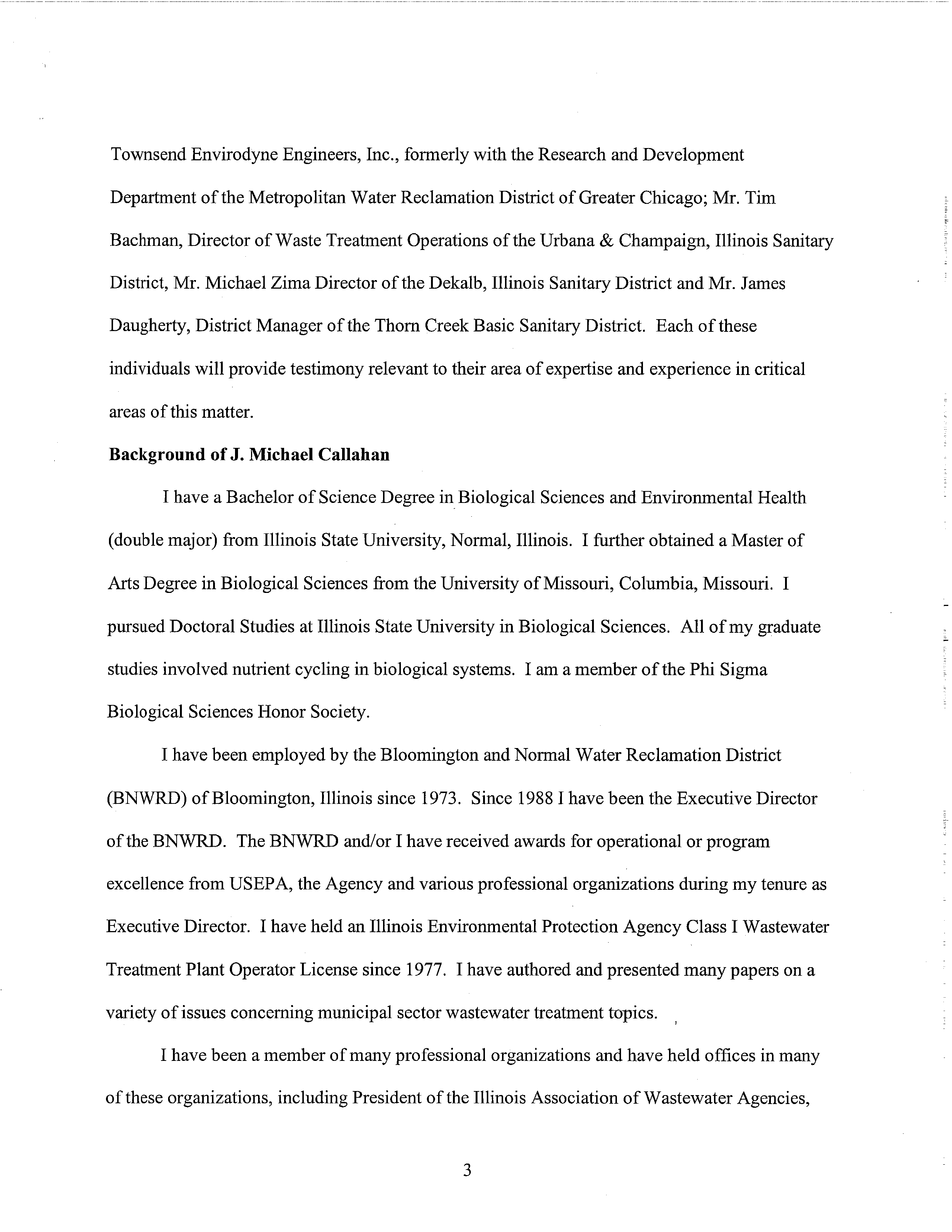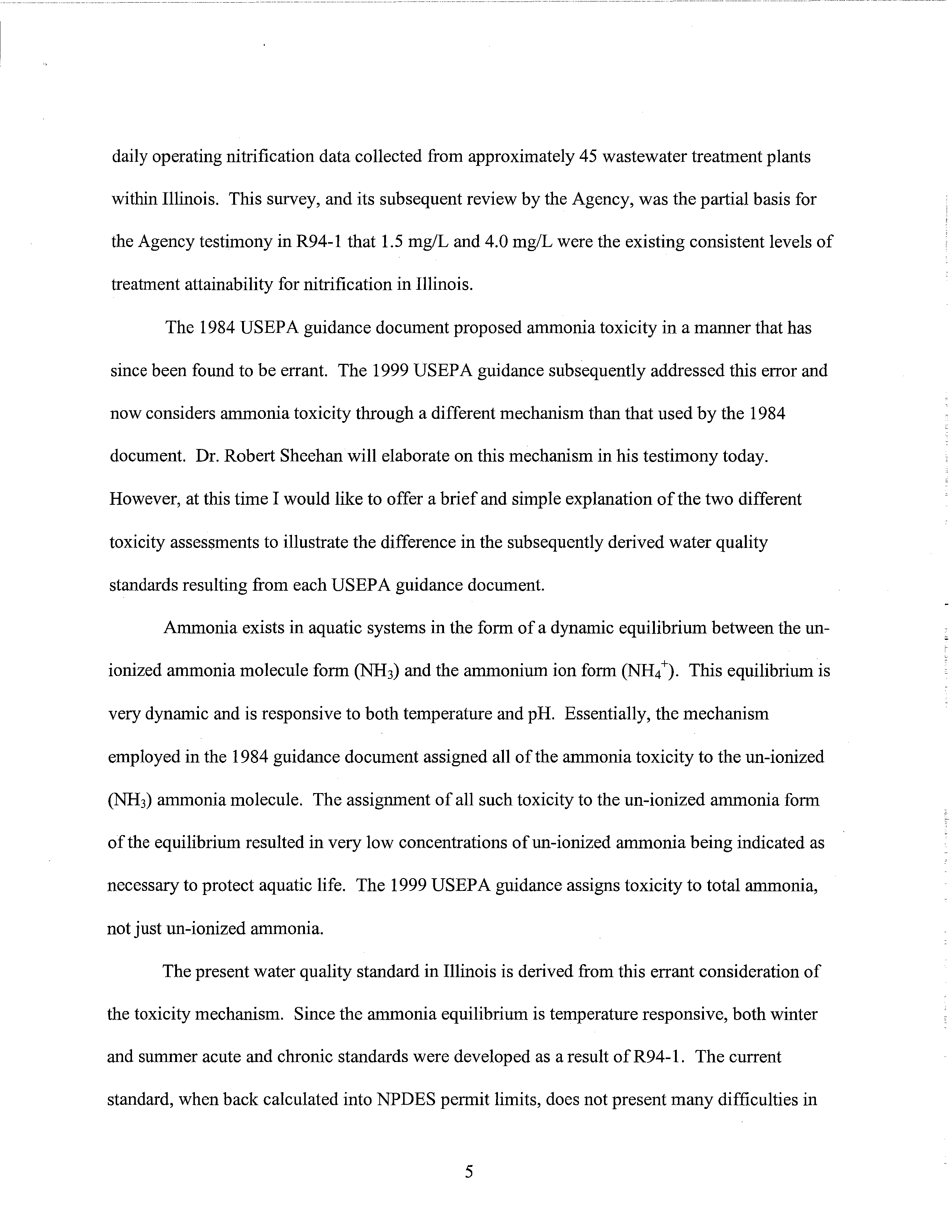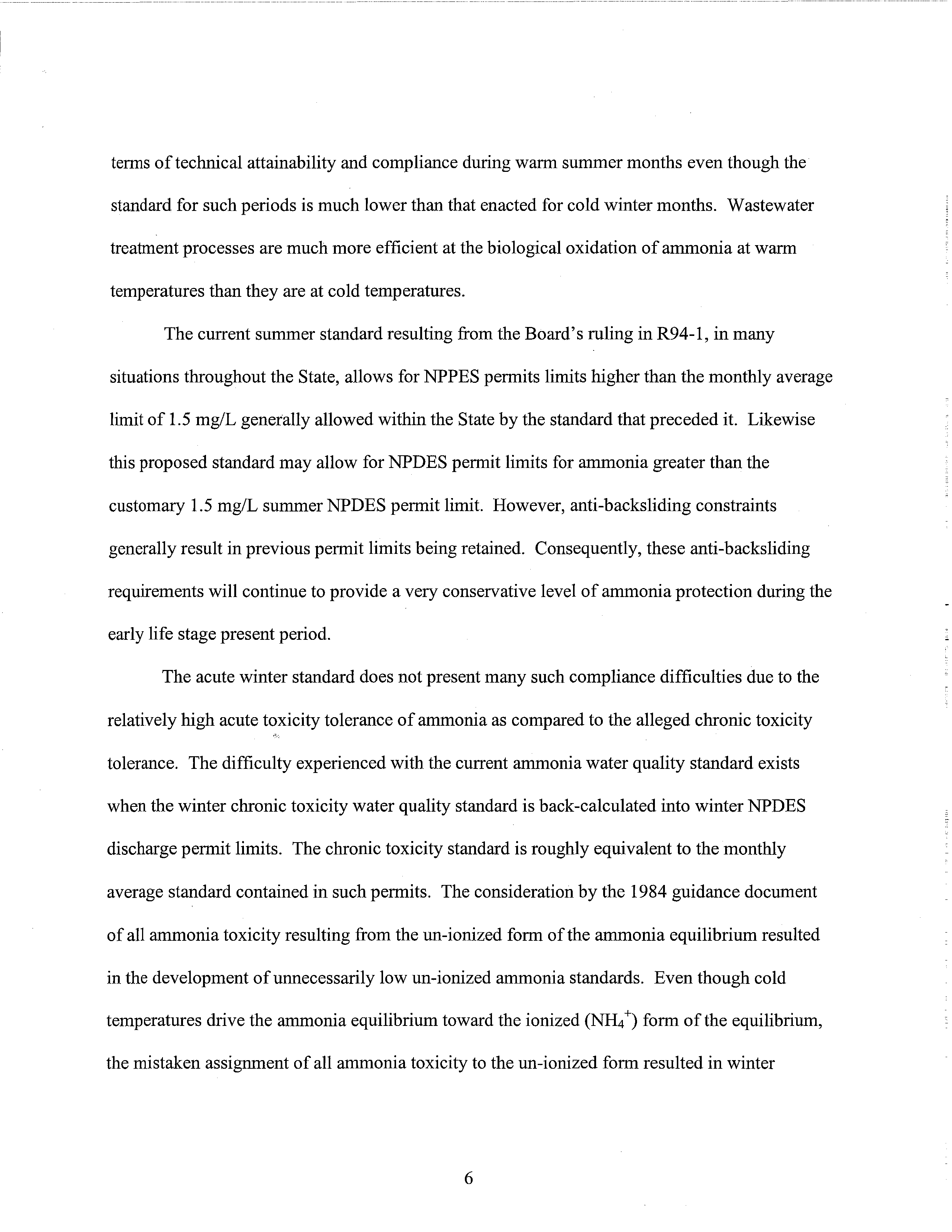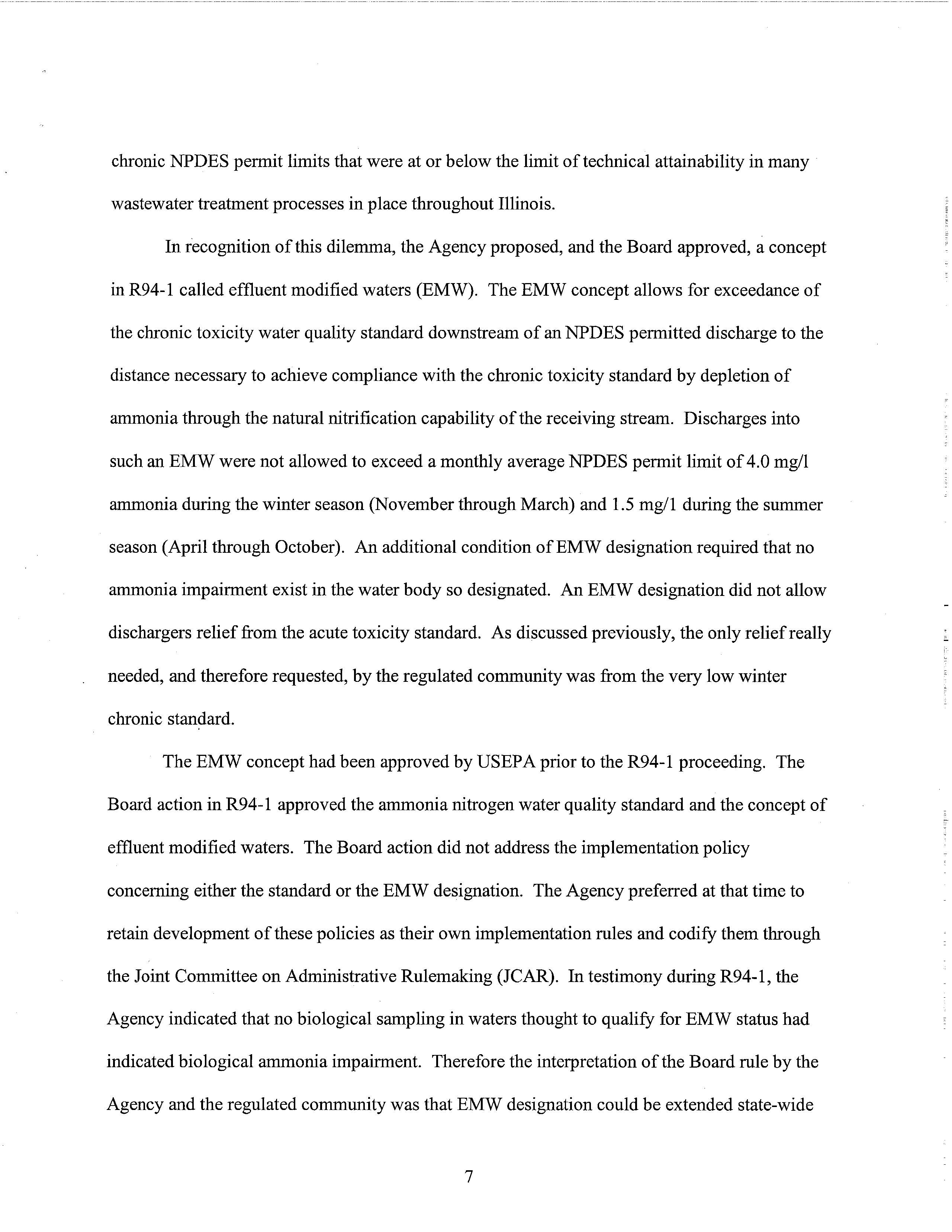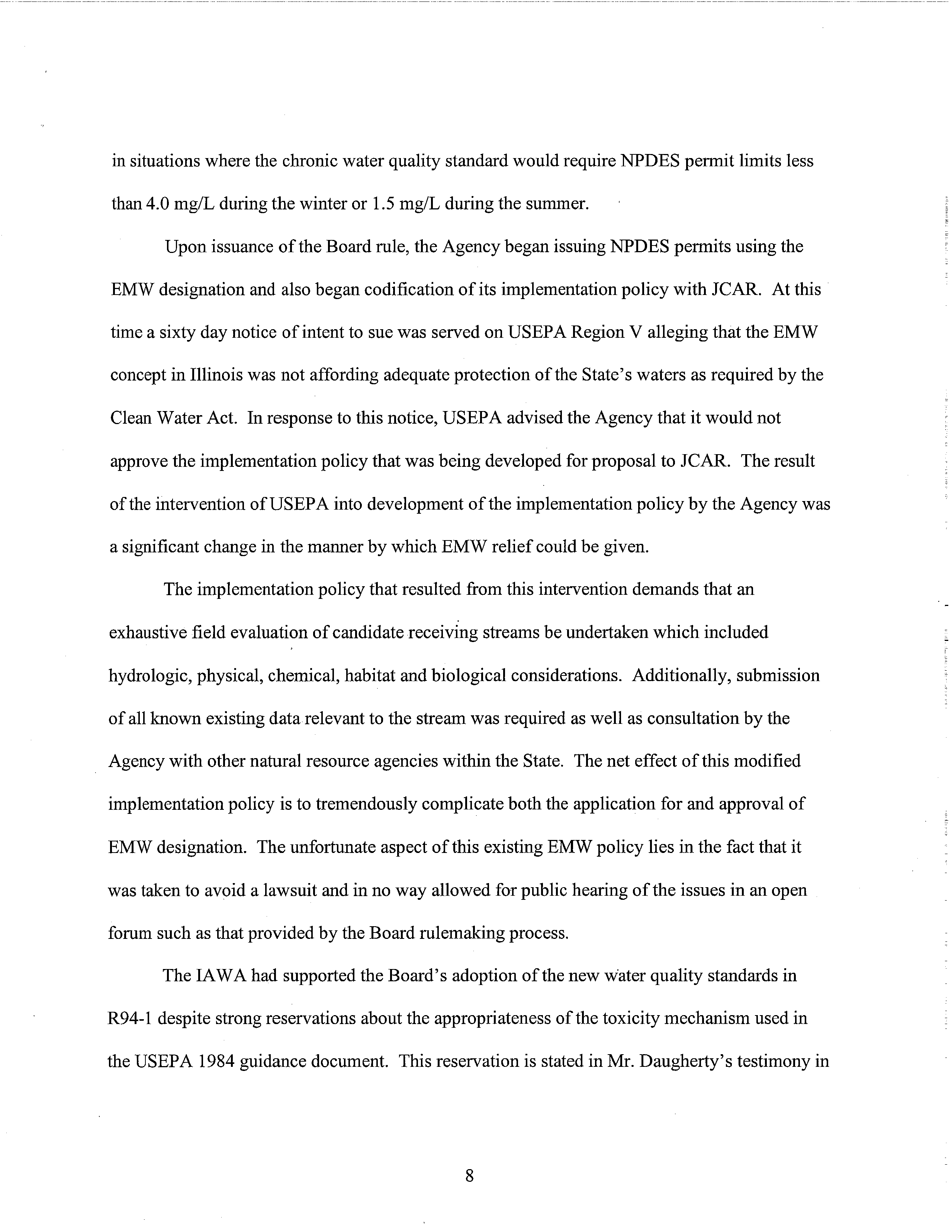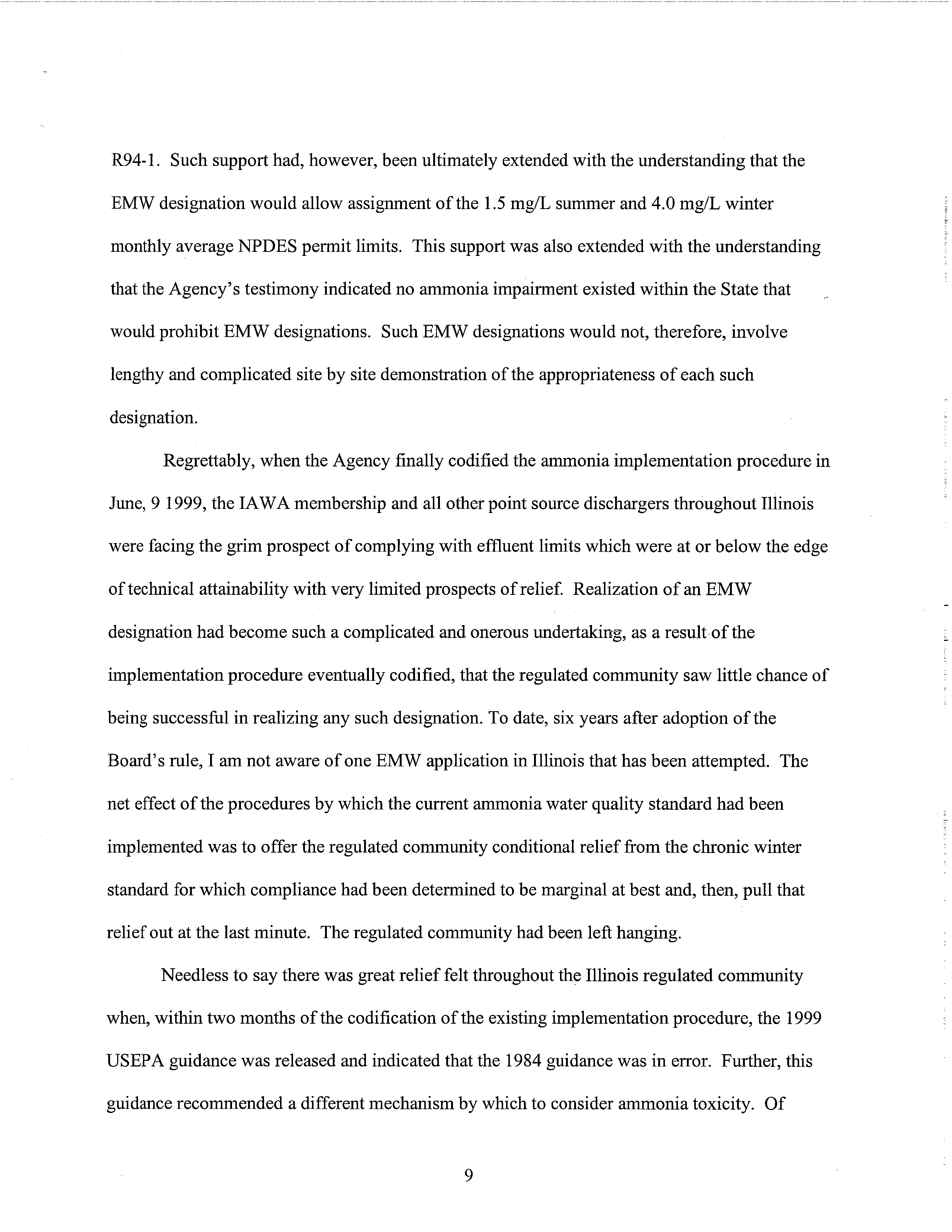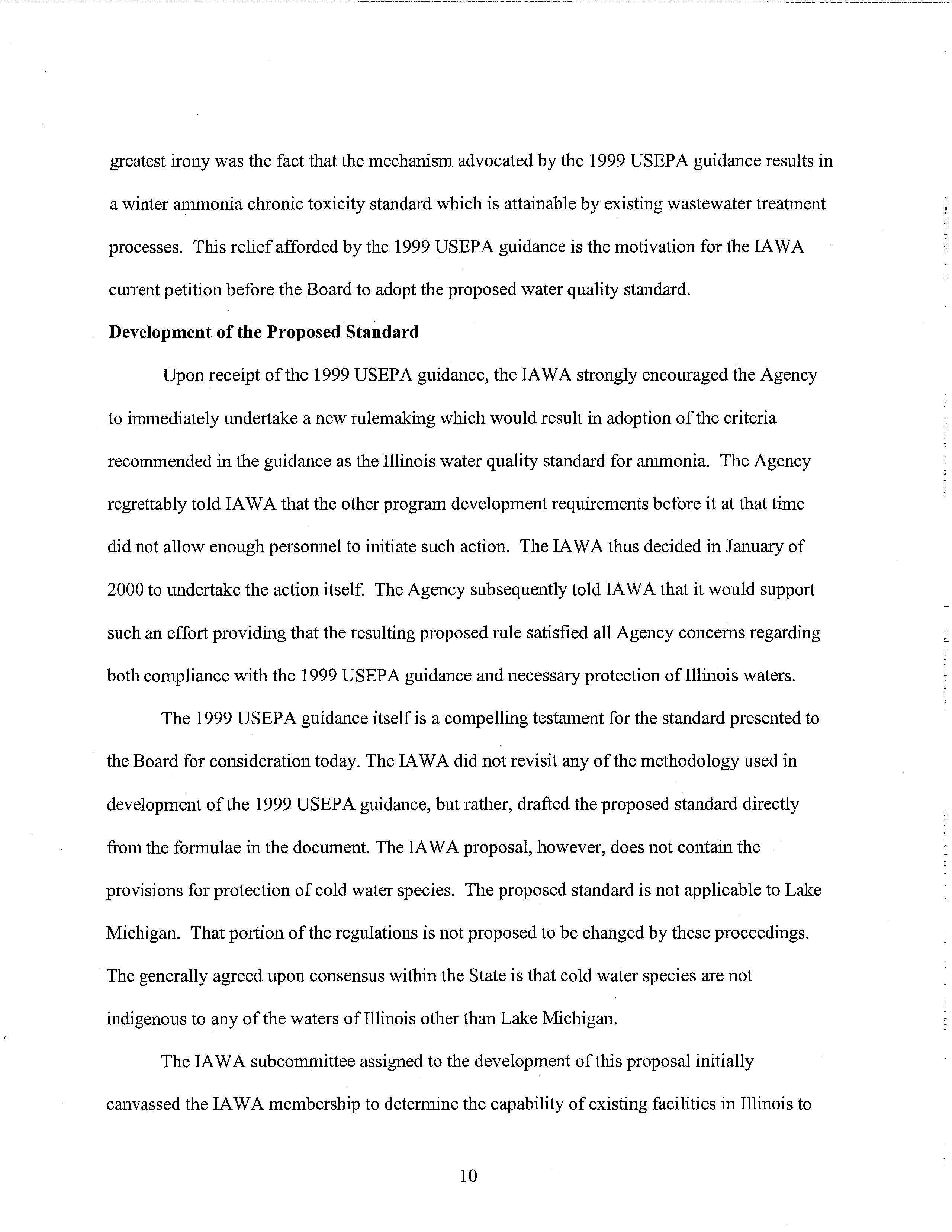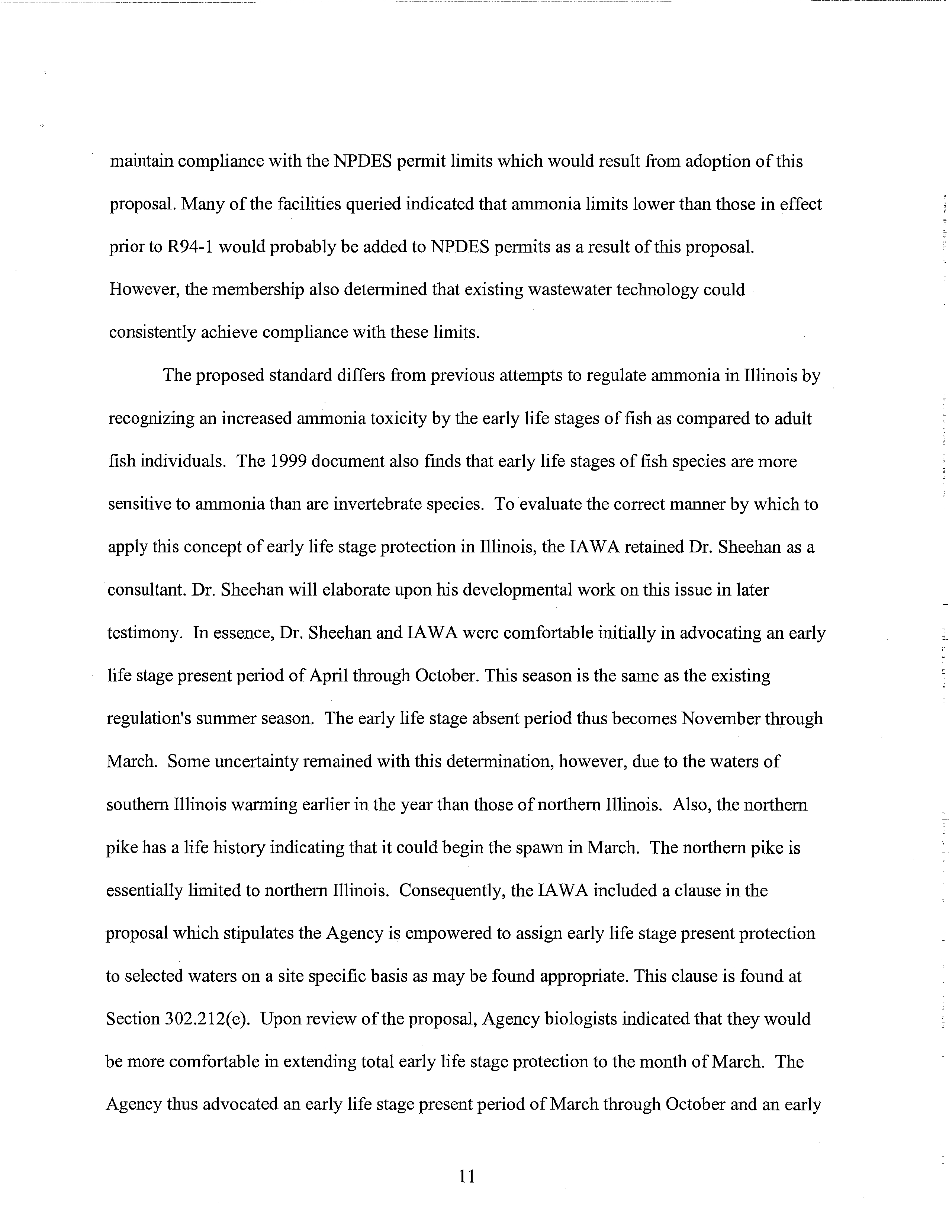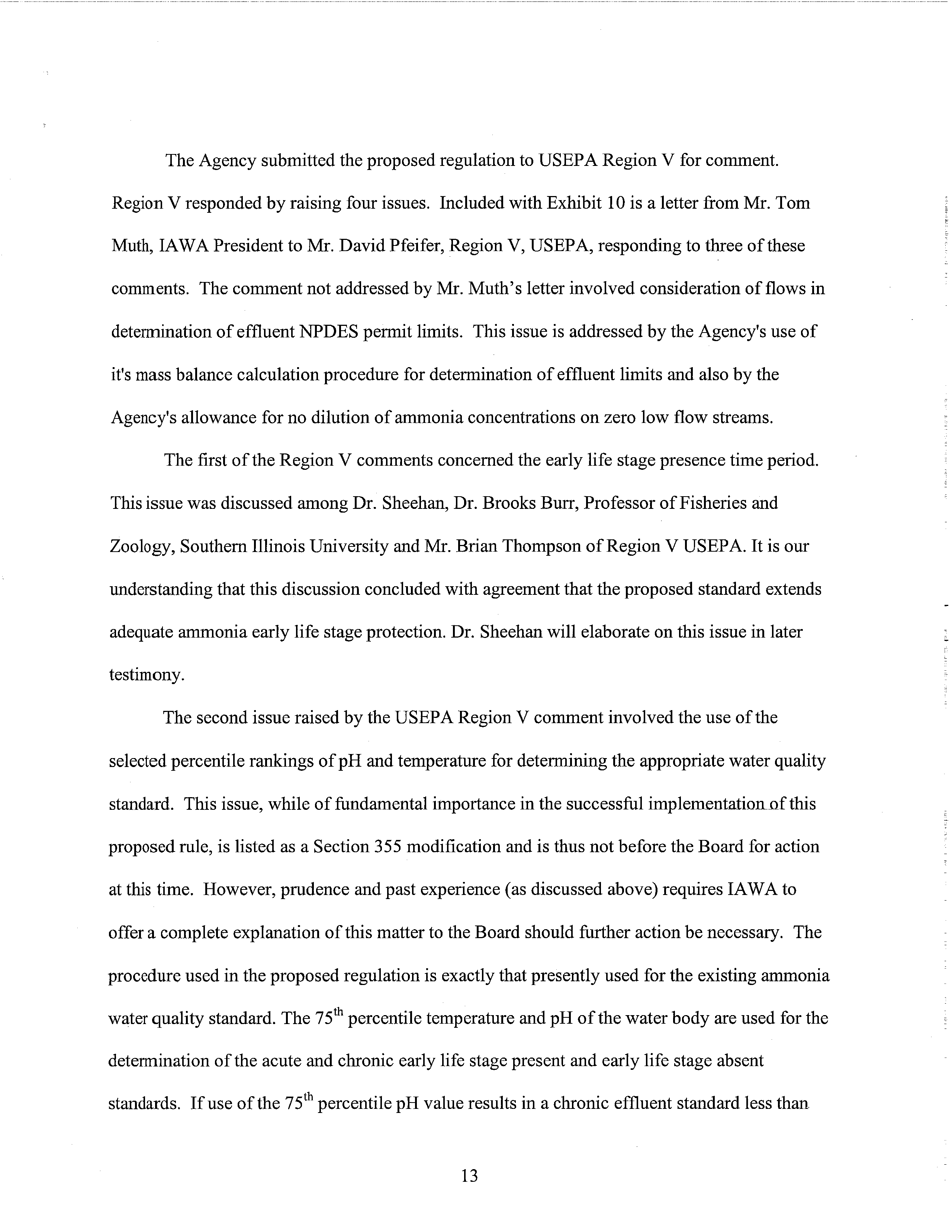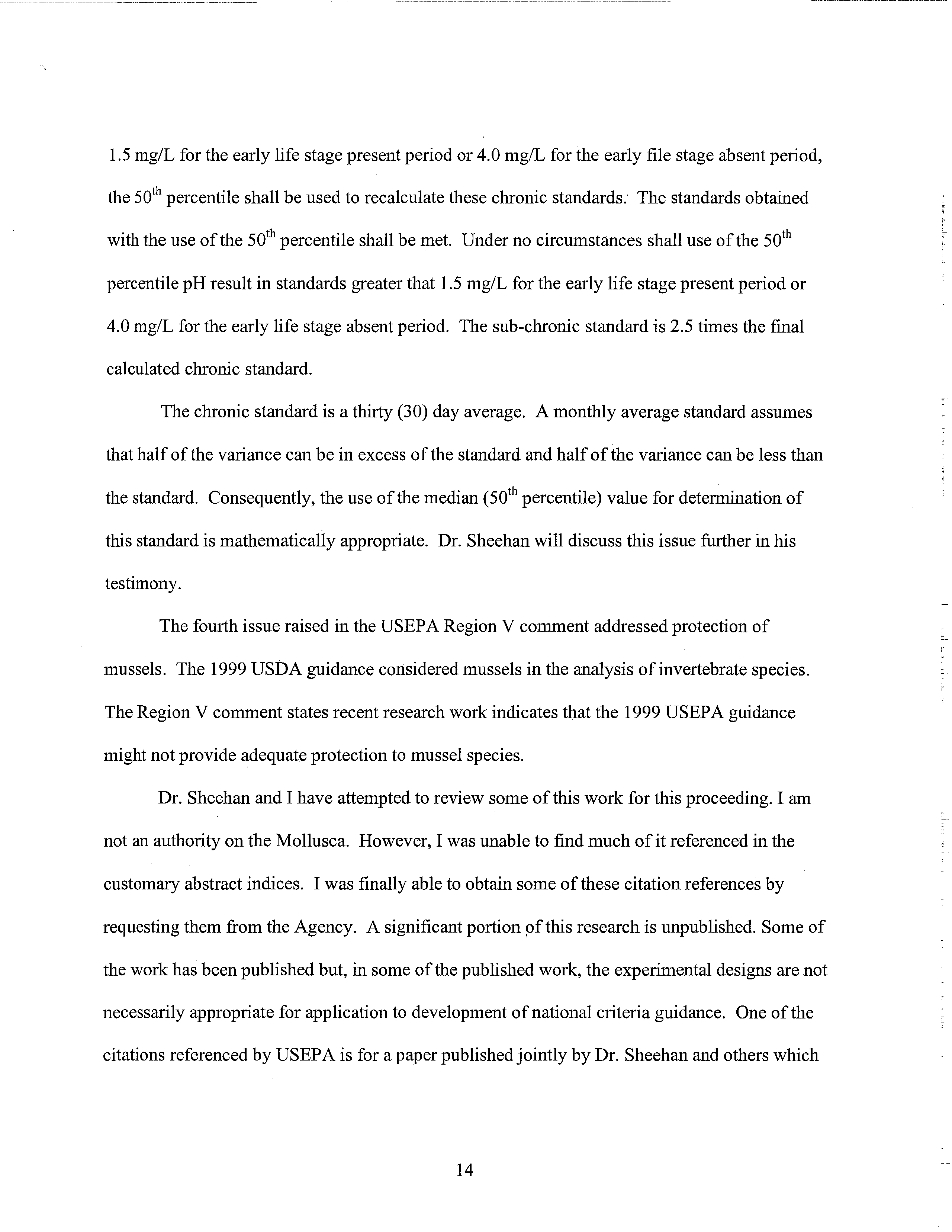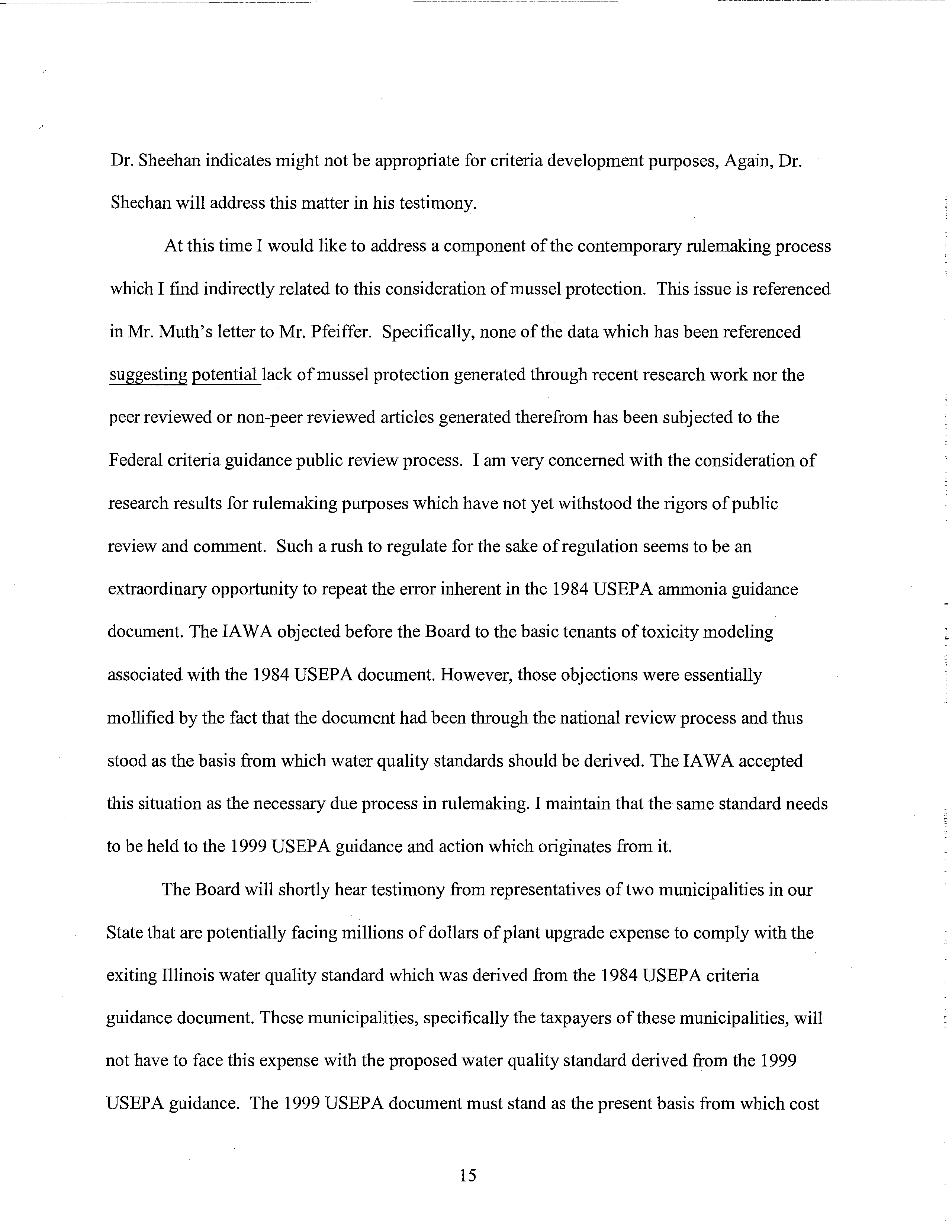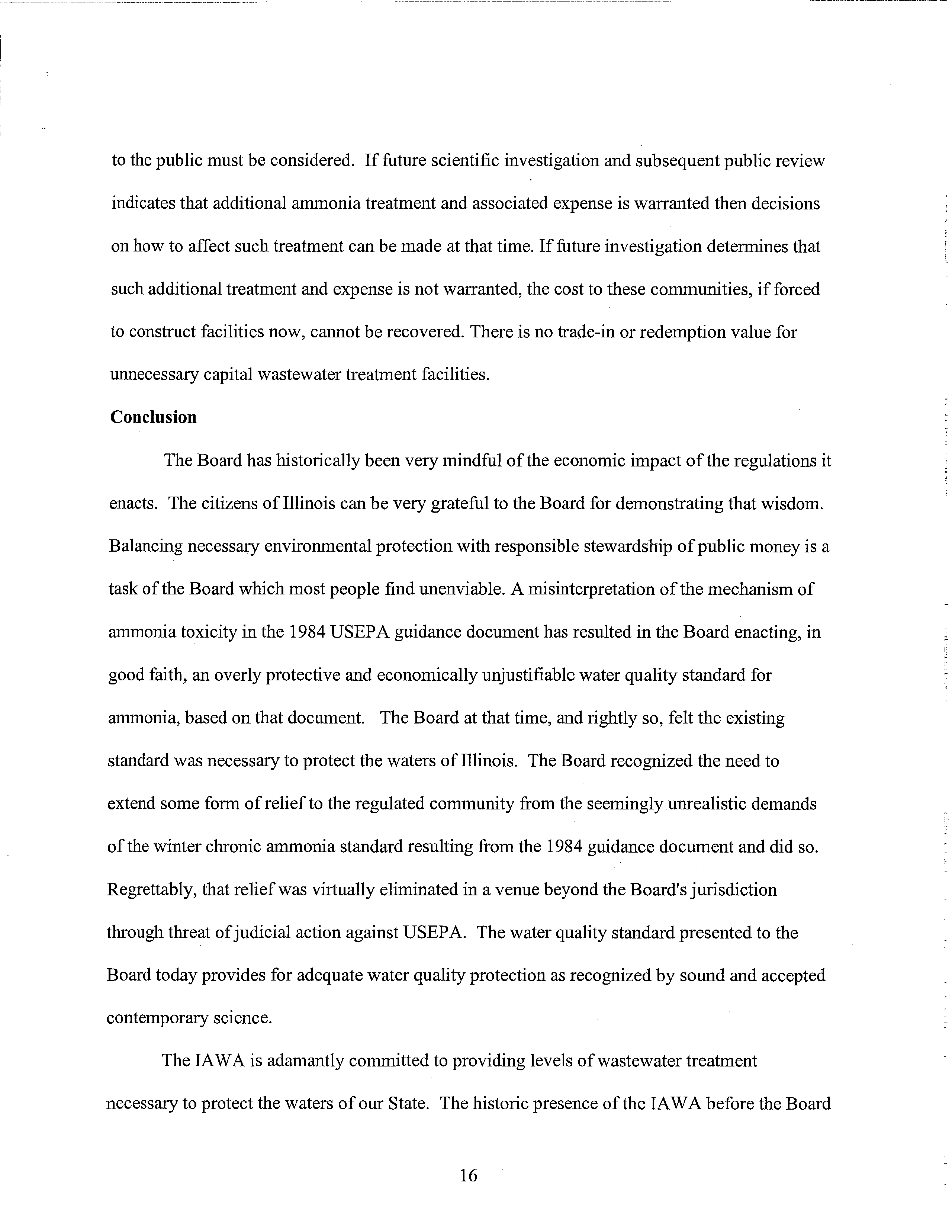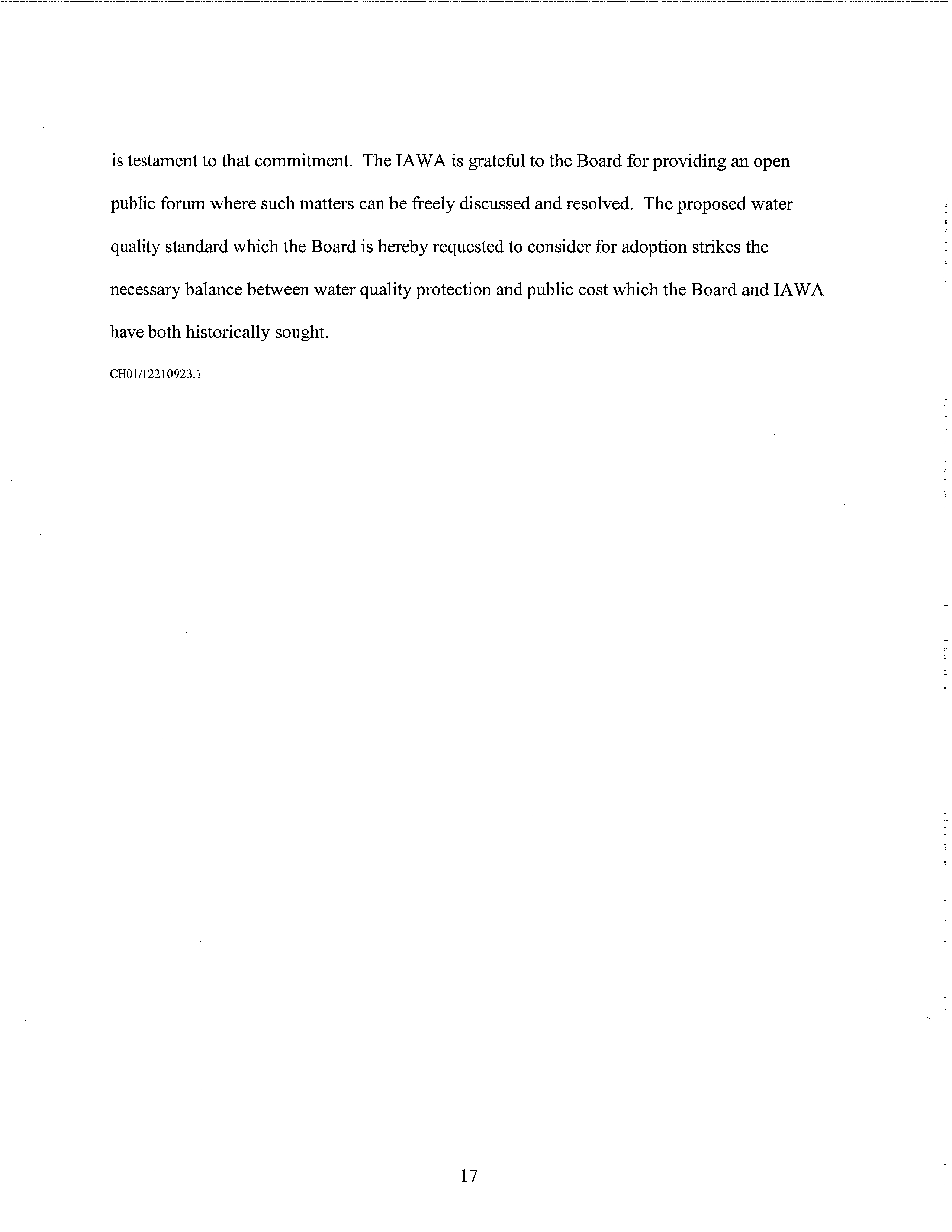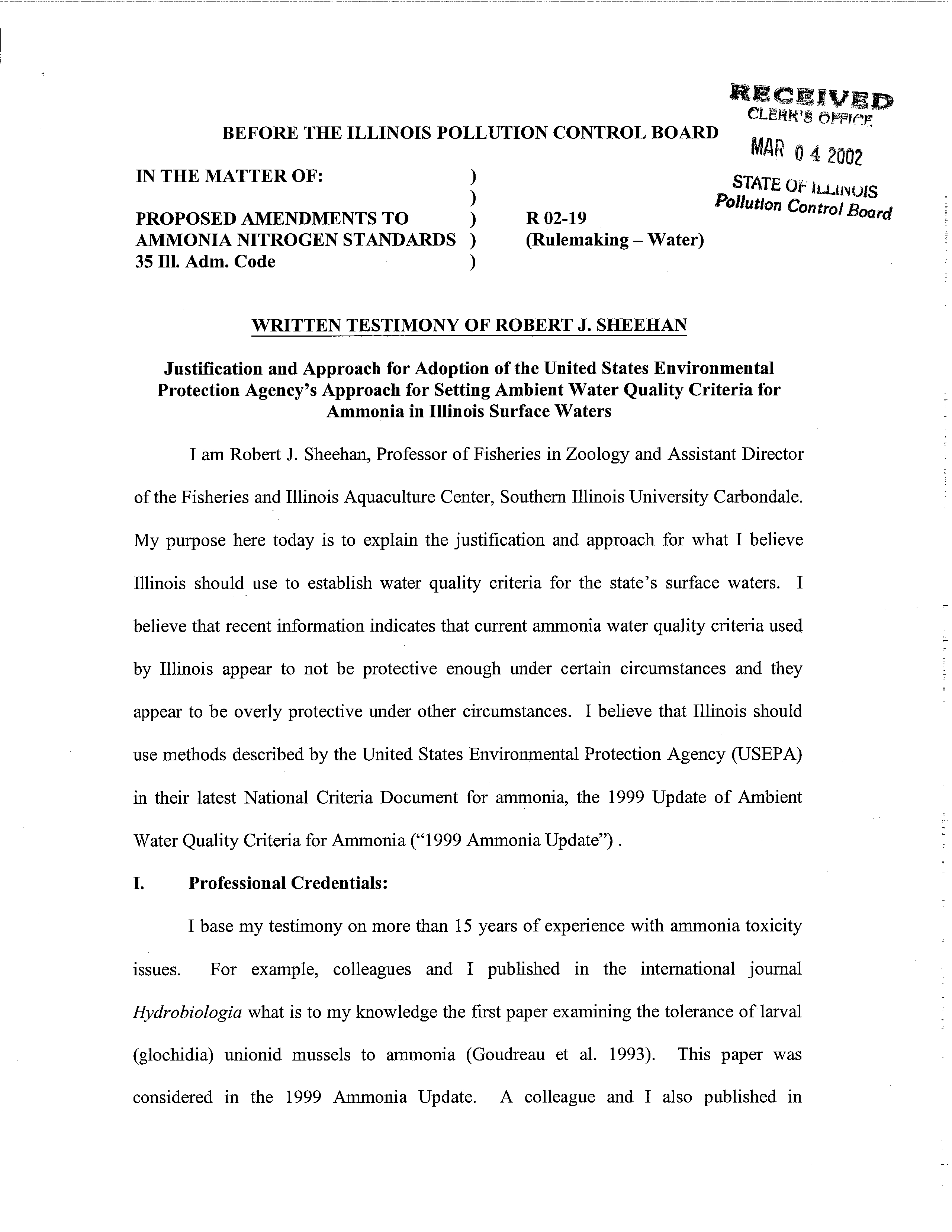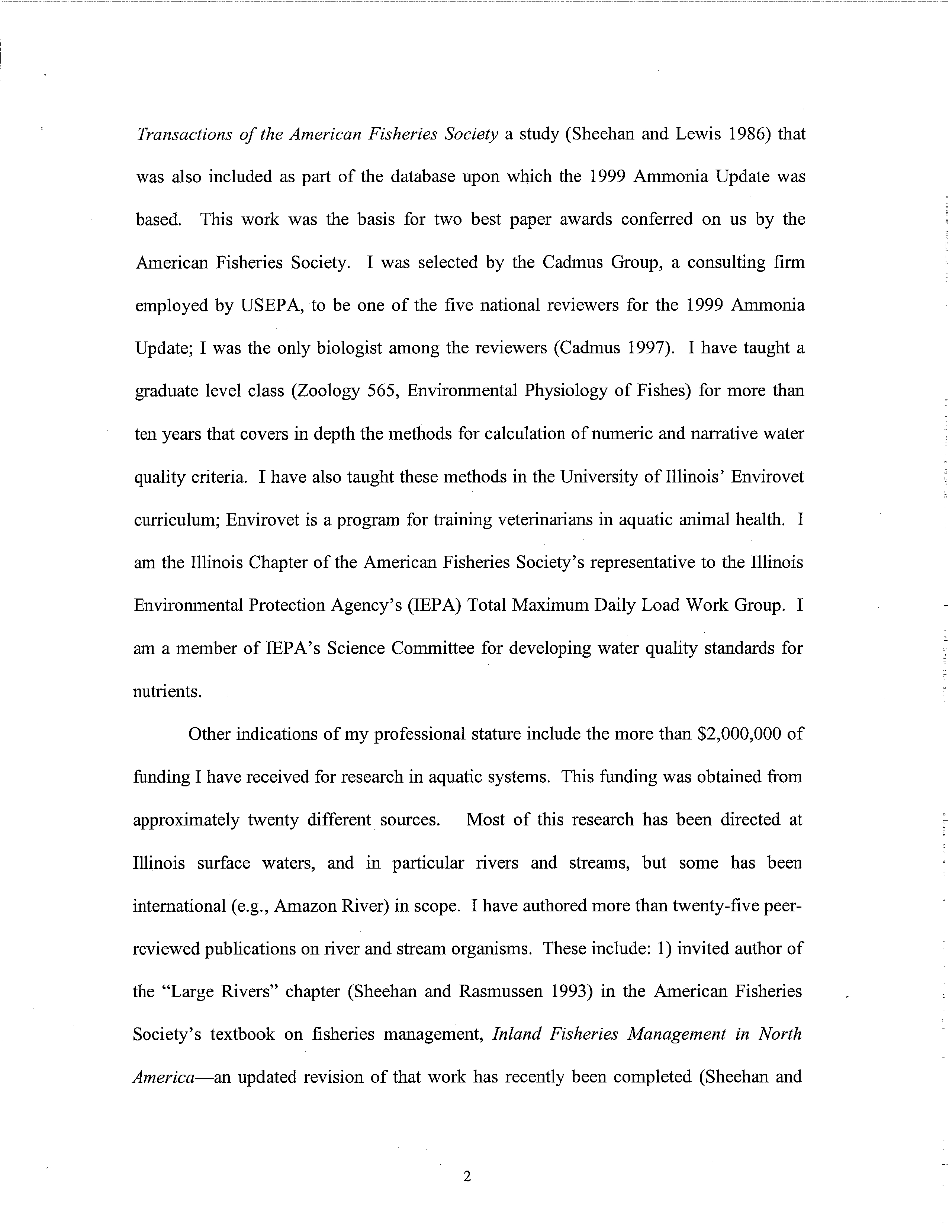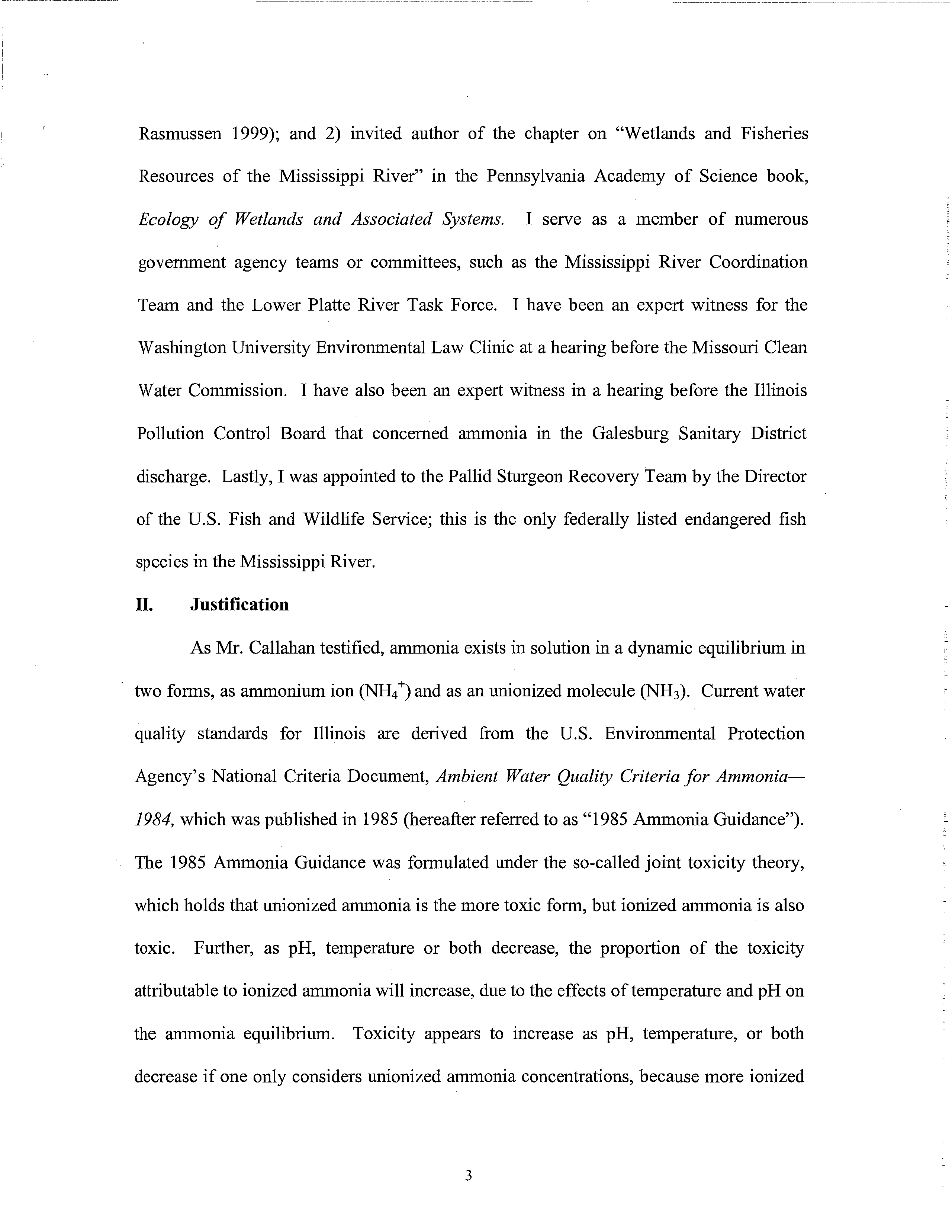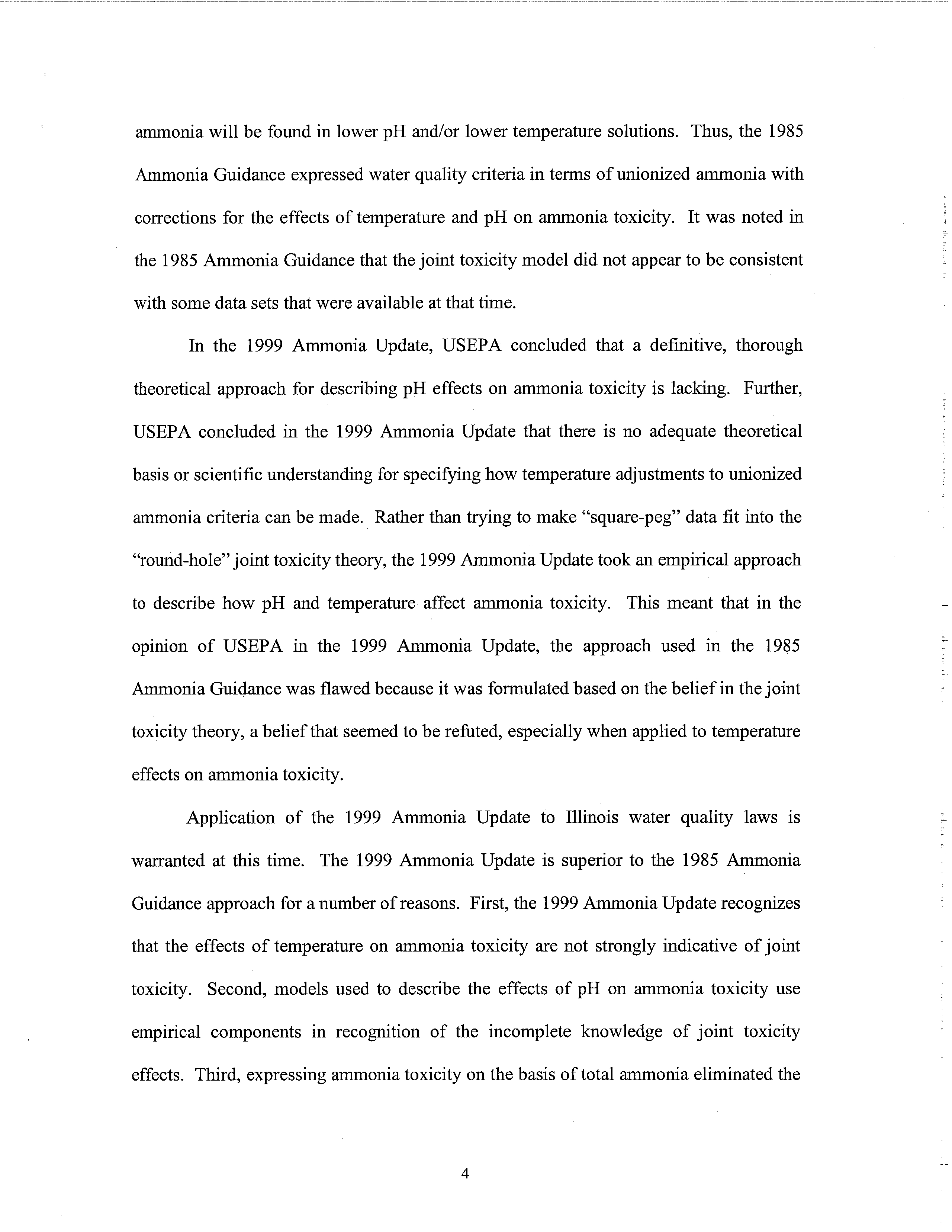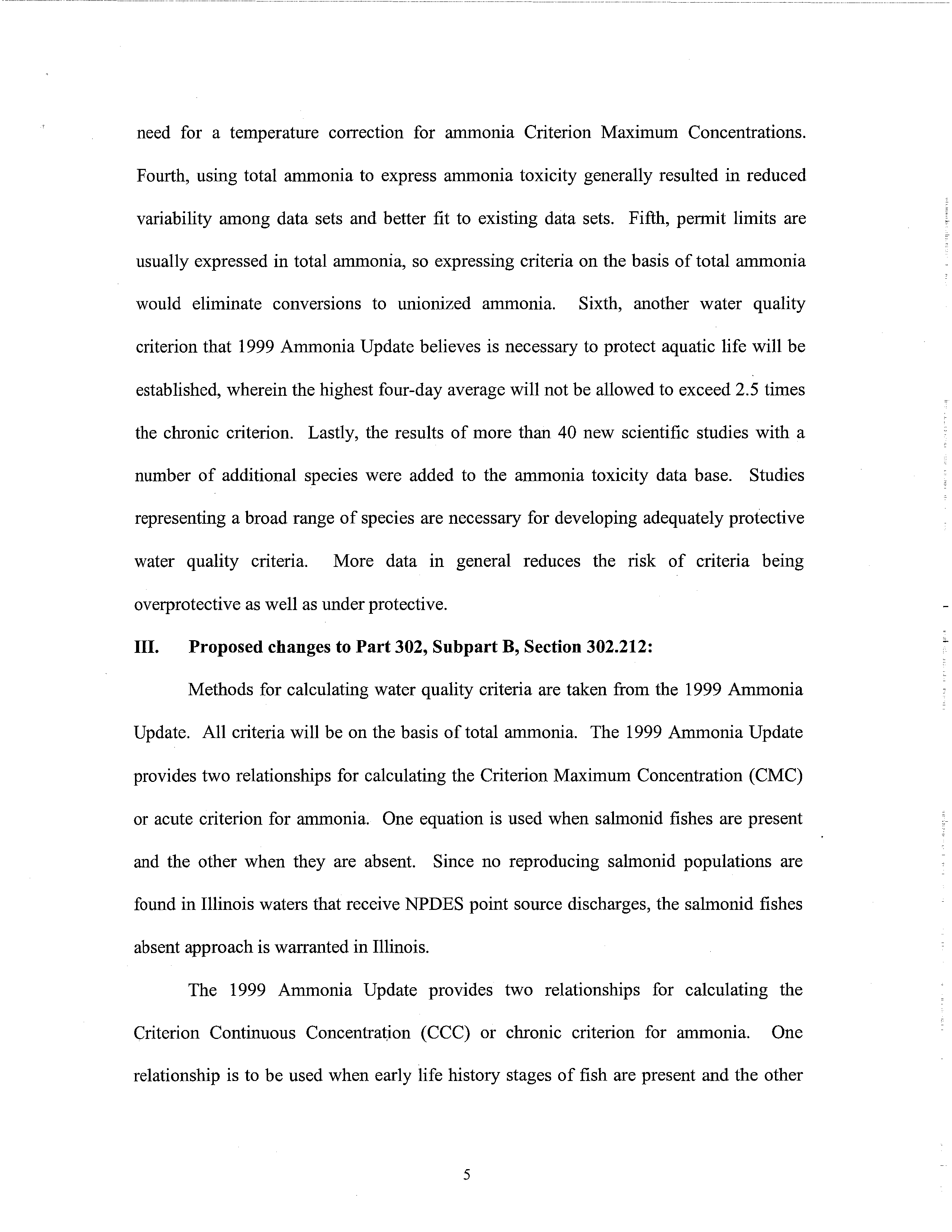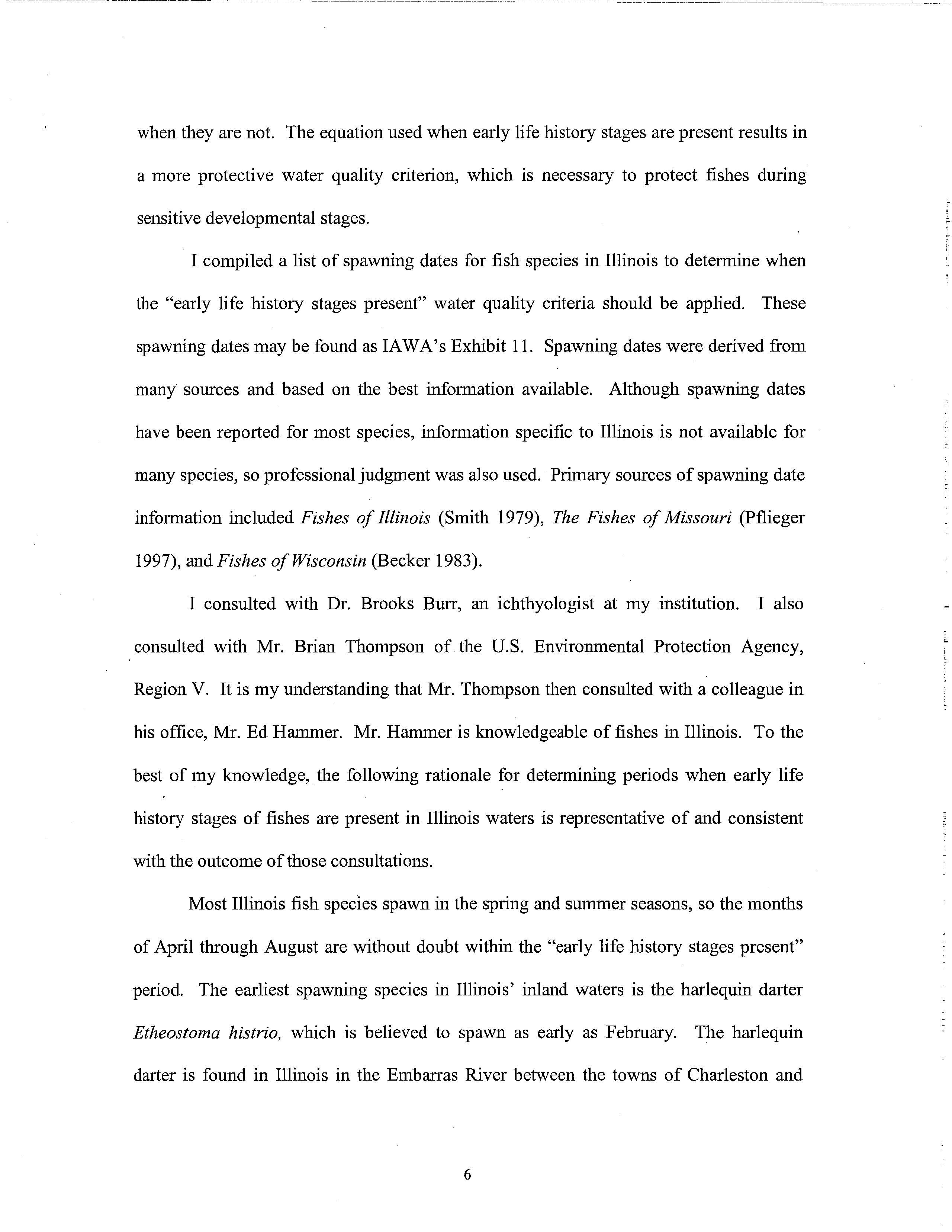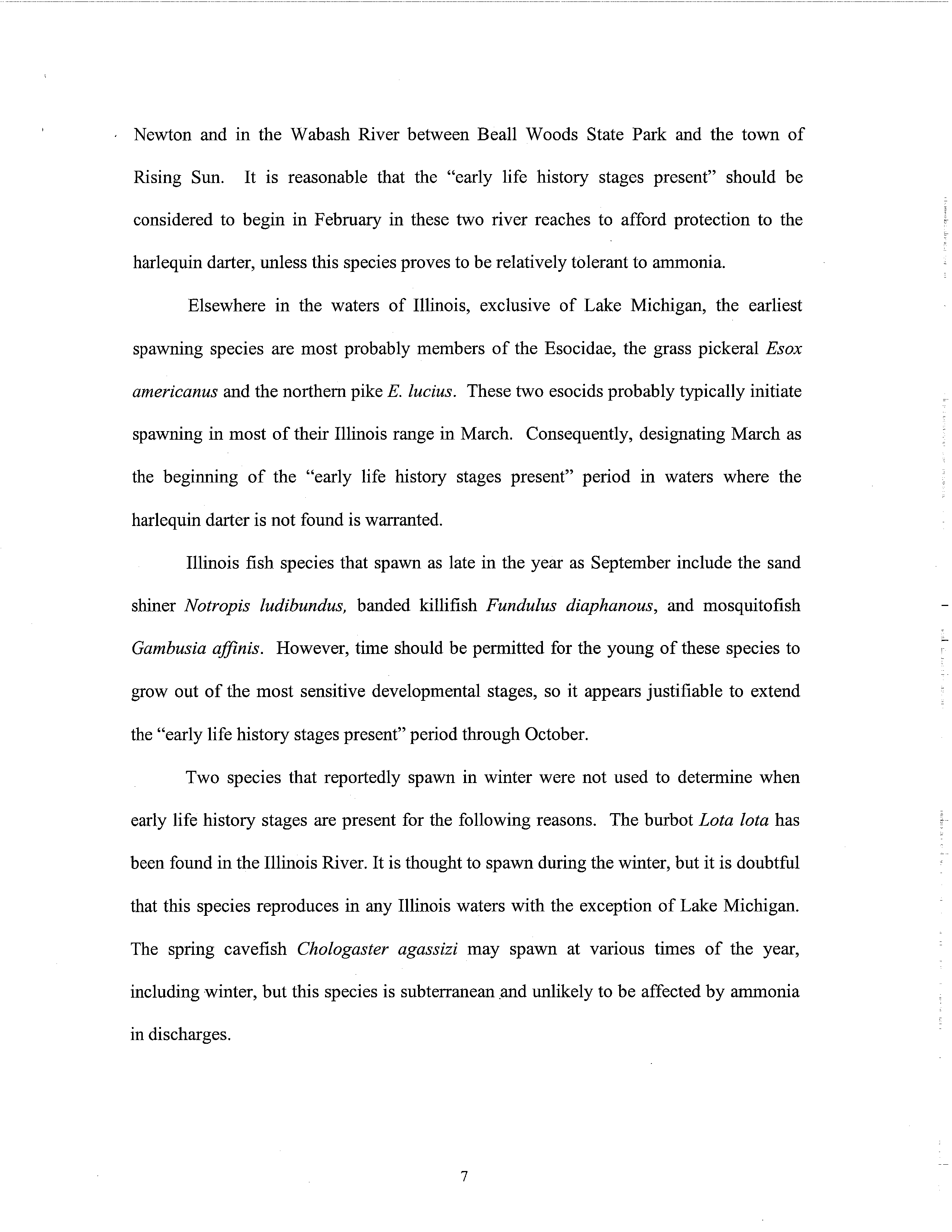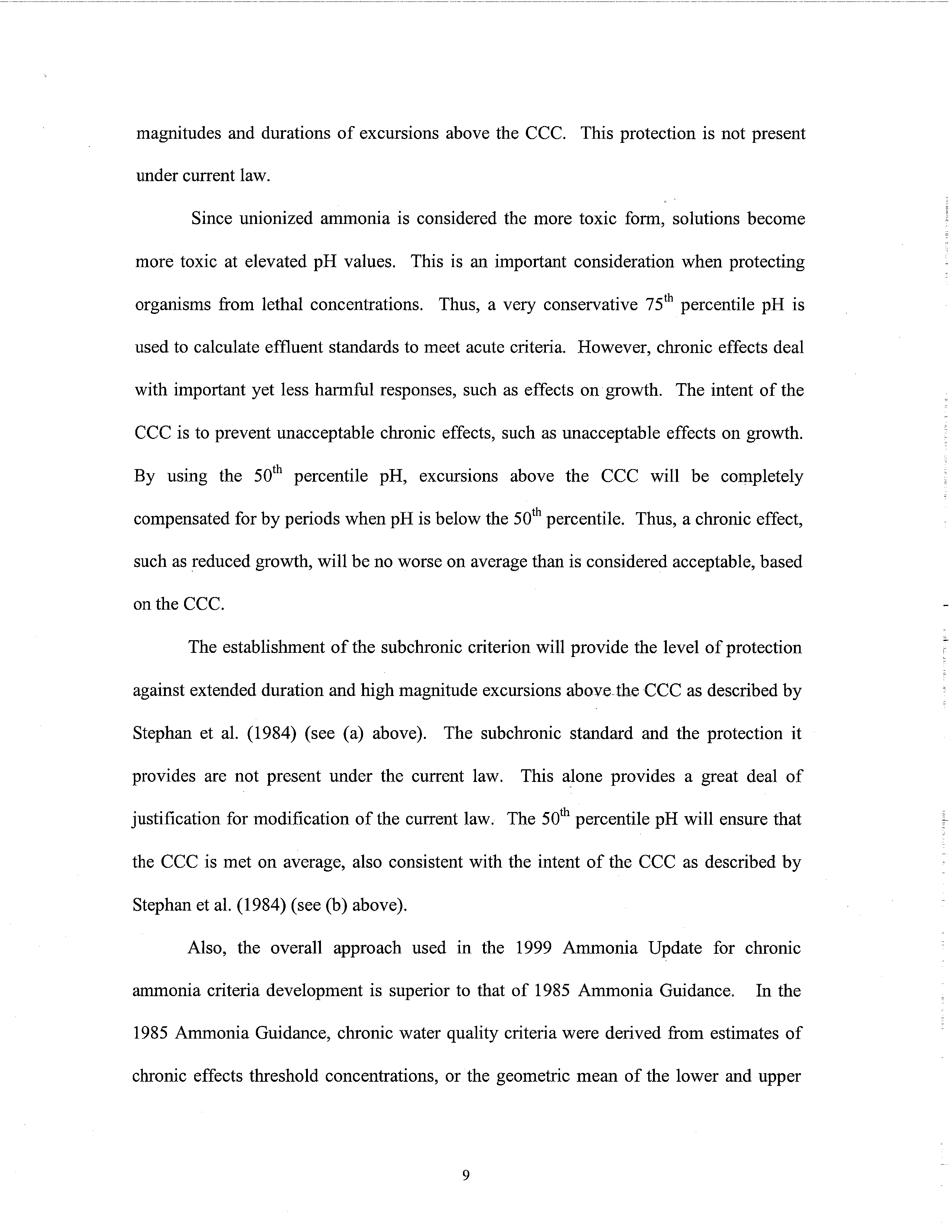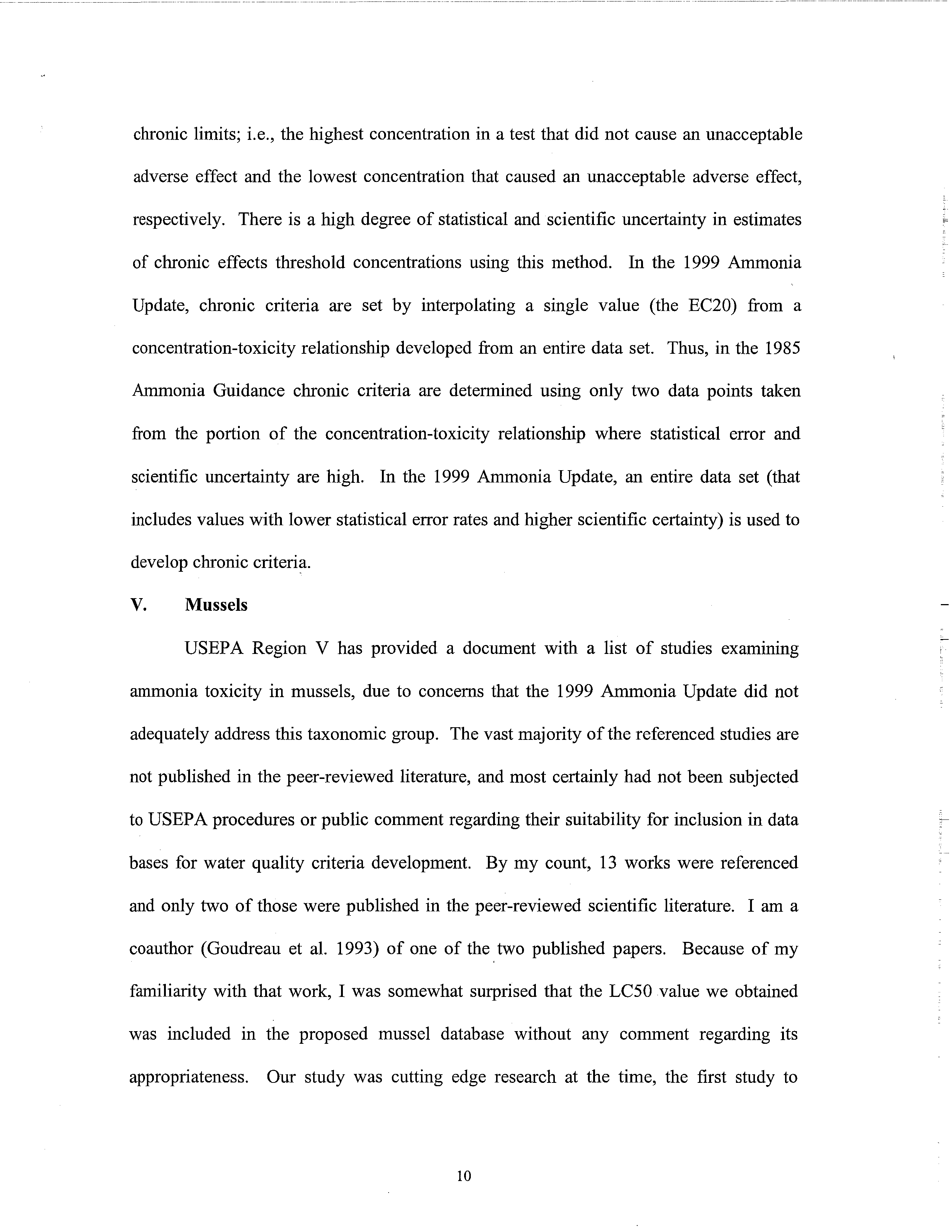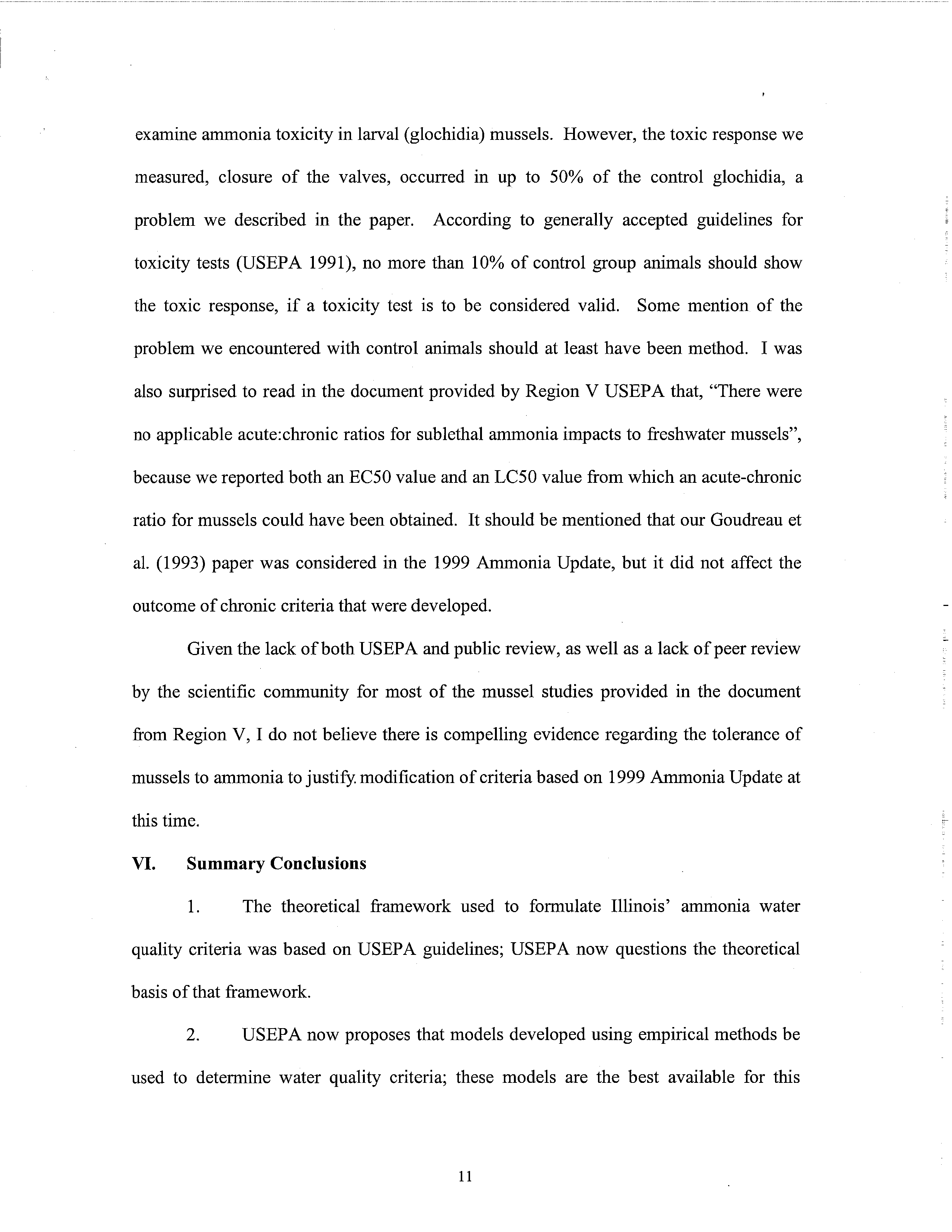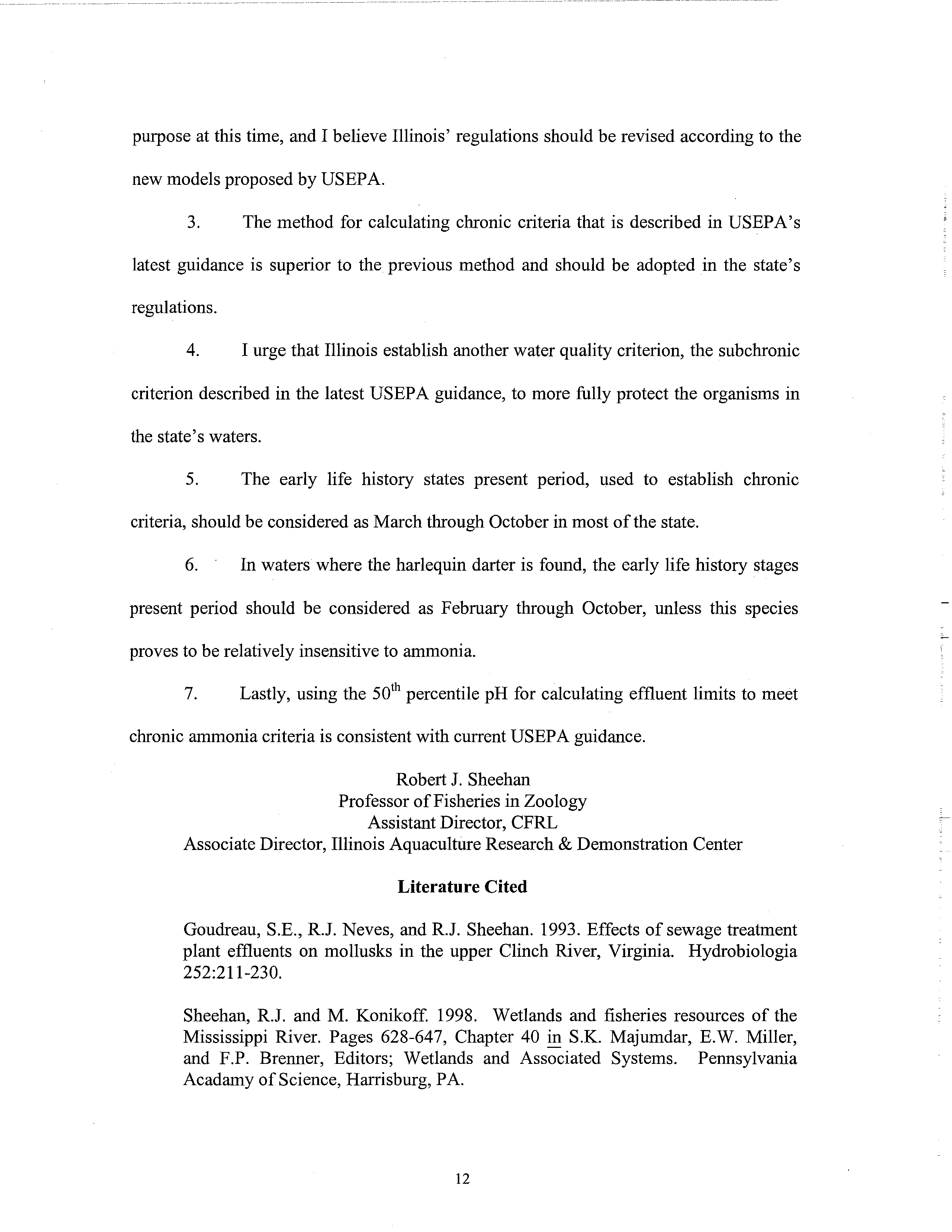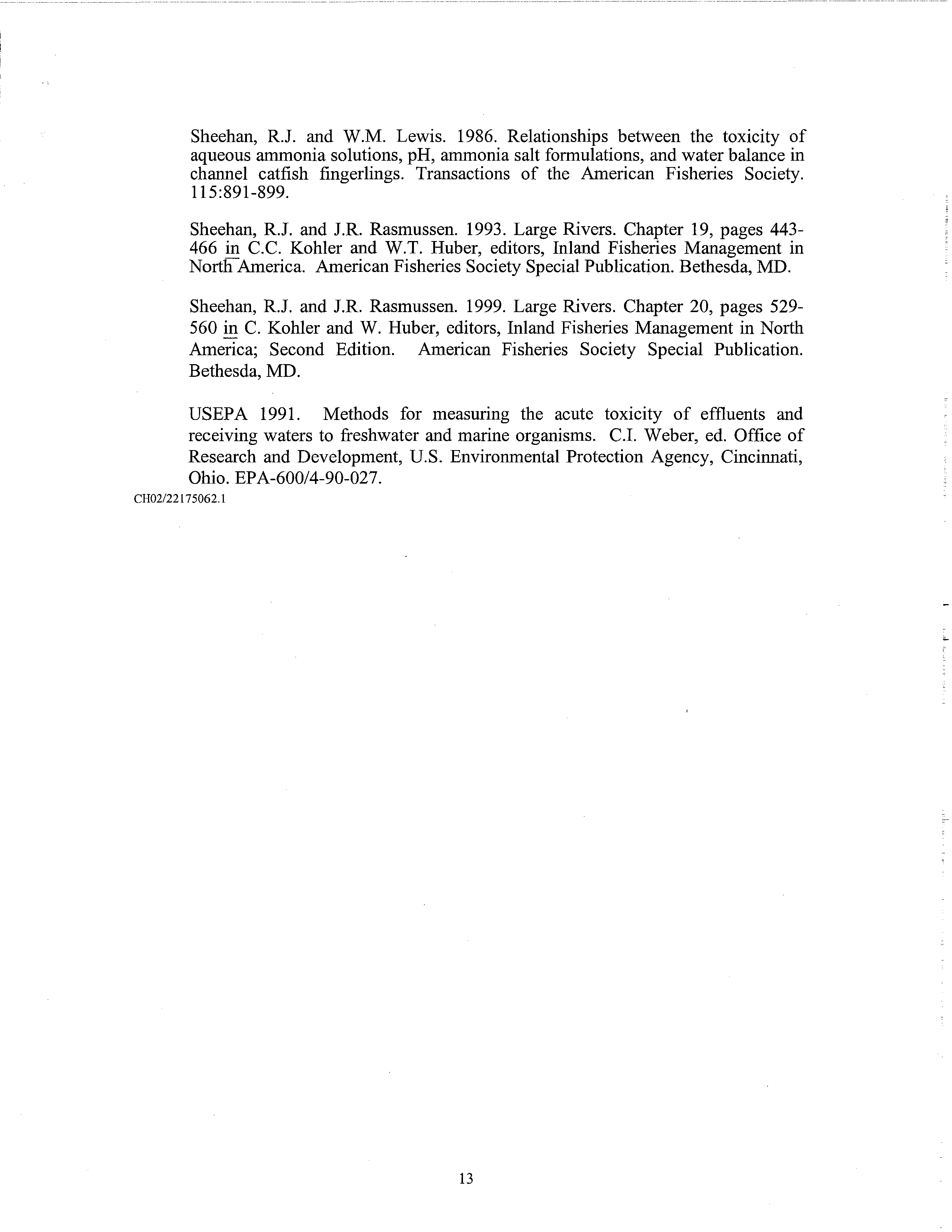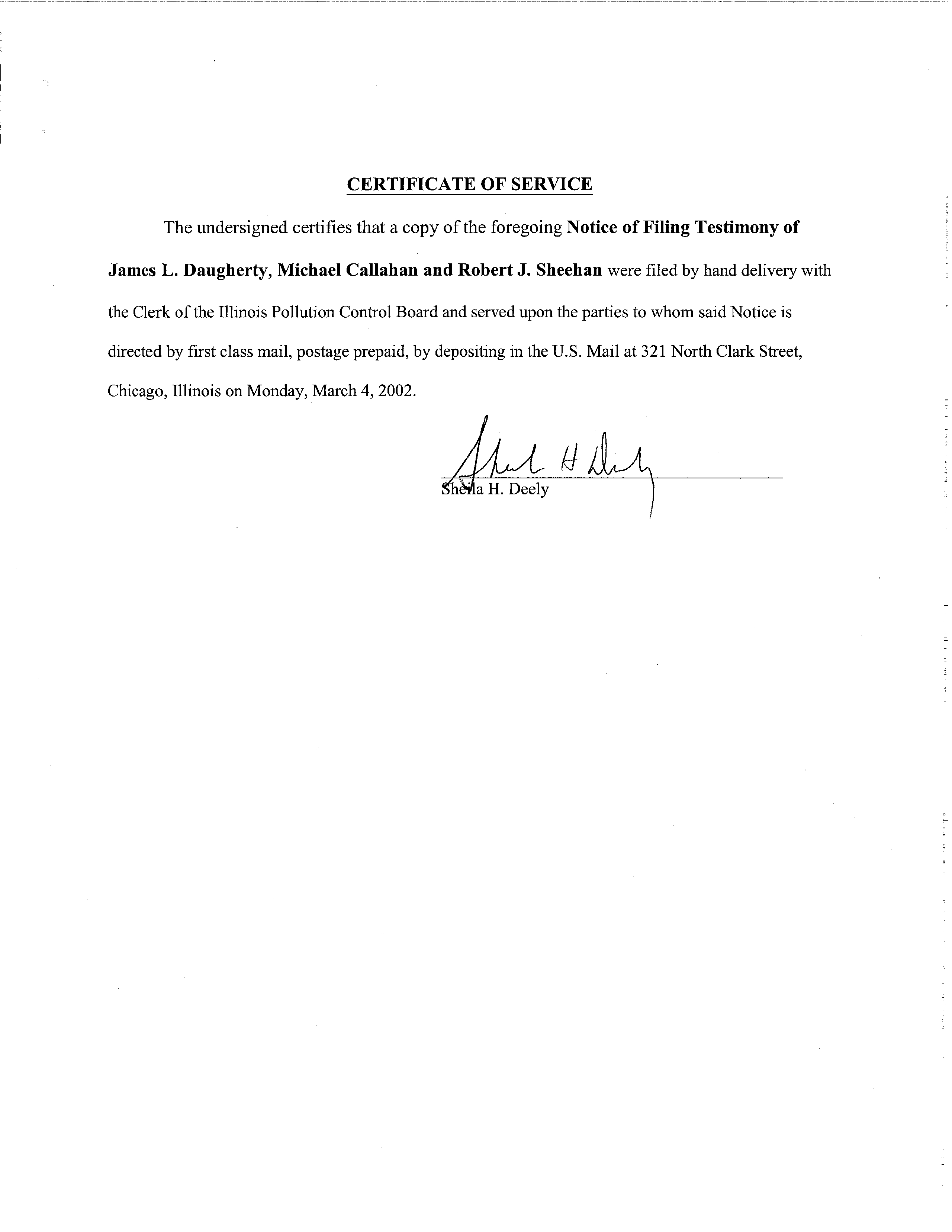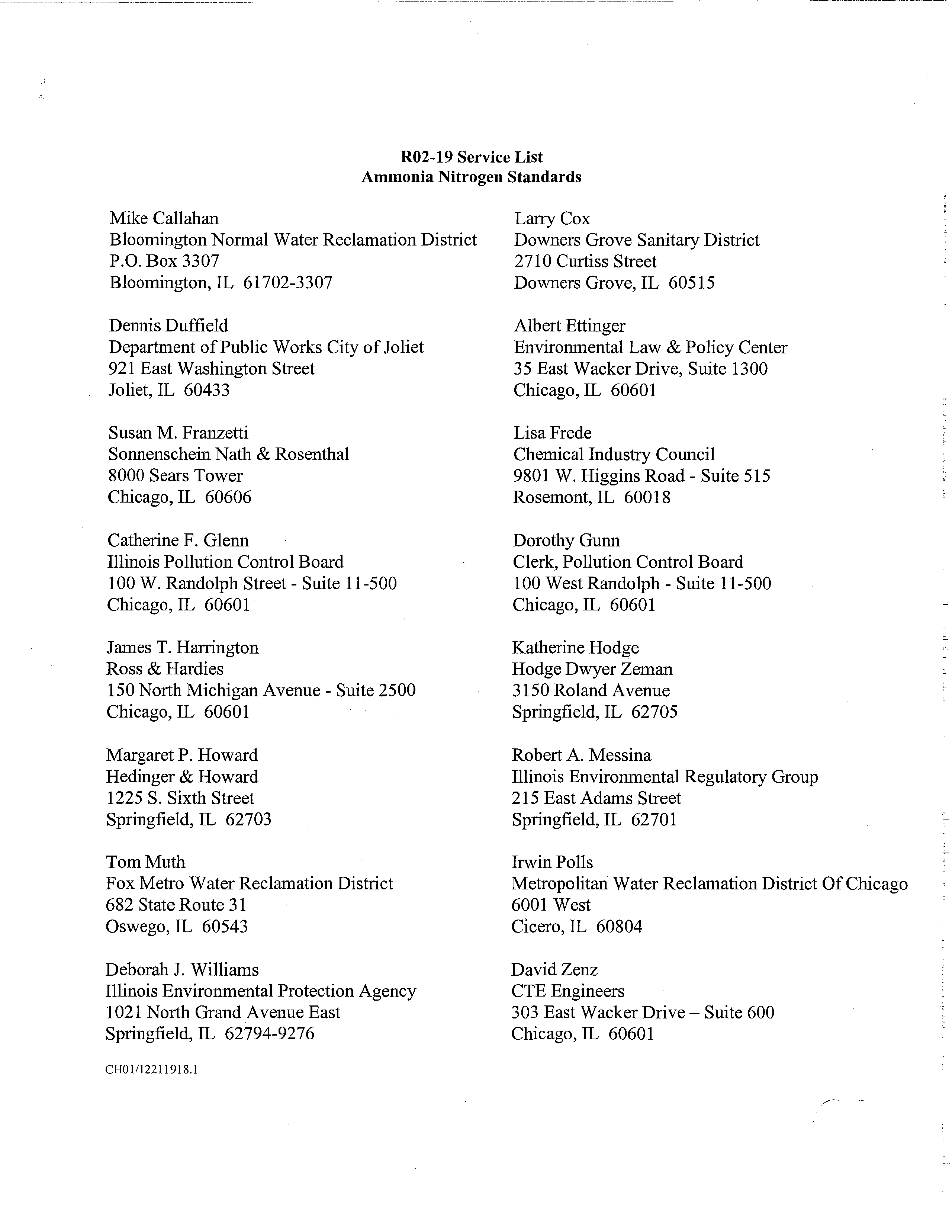R~CEJVED
BEFORE THE
ILLINOIS POLLUTION CONTROL
BOARDCL~R~5O~1~
W\R
0 4
2002
IN THE MATTER OF:
)
STATE O~
~LL*i~ji~
)
Pollution Control Board
PROPOSED AMENDMENTS TO
)
AMMONIA NITROGEN STANDARDS
)
35
IlL Adrn. Code
)
NOTICE OF FILING
TO:
Illinois Environmental Protection Agency
1021
North Grand Avenue East
P.O. Box 19276
Springfield,
IL
62794-9276
Office ofthe Attorney General
Division Chief ofEnvironmental Enforcement
188 West Randolph Street
Chicago, IL
60610
See Attached Service List
Dated:
March 4, 2002
Roy M. Harsch
Sheila H. Deely
GARDNER, CARTON & DOUGLAS
321 North Clark Street
-
Suite 3400
Chicago, Illinois
60610-4795
(312) 644-3000
Division ofLegal Counsel
Illinois
Environmental Protection Agency
1021
North Grand Avenue East
P.O. Box
19276
Springfield,
IL
62794-9276
R02-19
(Rulemaking
—
Water)
PLEASE TAKE NOTICE
today that I have filed with the Clerk ofthe Illinois Pollution
Control Board
Testimony of James L.
and Robert J. Sheehan
a copy ofwhich is herewith served
TIllS FILING IS SUBMITTED ON RECYCLED PAPER
RECEIVED
BEFORE THE
ILLINOIS
POLLUTION CONTROL
BOARfl~.ERK’S
OFFU’?
M14R
0
4
2002
STATE
OFILLIINUIS
IN
THE MATTER OF:
)
Pollution
Control Board
)
PROPOSED AMENDMENTS TO
)
R02-19
AMMONEA NITROGEN STANDARDS
)
(Rulemaking
-
Water)
35 ILL. ADM. CODE 302.212, 302.2 13,
)
AND
304.122
)
TESTIMONY OF
JAMES
L.
DAUGHERTY
Background:
My name is
James Daugherty.
I
am employed
as District
Manager by the Thom Creek
Basin
Sanitary
District.
The
District
serves
100,000
people
in
six
communities
located
in
southern Cook
and
northeastern
Will
Counties,
Illinois.
The District’s
wastewater treatment
facility
provides
tertiary treatment
and
discharges
to
Thom
Creek,
a
tributary
of the
Little
Calumet River.
The Thorn Creek plant has been producing a nitrified effluent since May of 1977 when a
plant
addition
went
online.
I
have been the
certified
operator of the
facility since November
1976,
holding
an
Illinois
Environmental
Protection
Agency
(Agency)
Class
I
Wastewater
Treatment Plant Operators License.
I
have
been
employed
by
the
TCB
Sanitary
District
since
1973.
My
educational
background includes both a bachelor’s and
master’s degree in
environmental
engineering
from
the University ofIllinois.
I have authored many technical papers
and presentations.
Two of the
papers
are especially relevant here.
I presented a paper titled “Fundamentals ofNitrification in
Activated Sludge” at the
1986 Conference ofthe Illinois
Association ofWater
Pollution Control
Operators.
In
1987,
I
authored
a paper
for the
Illinois
Association
of Sanitary
Districts
on
1
“Development ofEffluent Ammonia Limits for Plants Discharging to Low Flow Streams”.
I am
a member of and have held offices in many professional organizations.
My
professional
involvement
with
ammonia
toxicity
and
ammonia
water
quality
standards coincides with the State of Illinois’ efforts to
limit ammonia discharges.
In 1972, I was
studying under Dr. John Pfeffer at the University of Illinois, while he was actively involved with
the
state
in
the development of the
first
ammonia
water quality
standards.
My
research was
directed
by Dr.
Pfeffer
and
involved
evaluating the
environmental impacts
of a new de-icing
compound that consisted primarily of organic nitrogen compounds.
My research evaluated the
toxicity ofthat de-icing compound to
the aquatic environment.
The results demonstrated that the
primary toxic component was the ammonia nitrogen present in the de-icing compound, as well as
that produced during decomposition of the organic nitrogen compounds.
My research included
review of the literature
on
ammonia toxicity, the
same literature being used at that time by the
state to
propose the first
ammonia toxicity standard.
When I started with
the Thorn Creek Basin
Sanitary
District
in
1973,
the
District
was
conducting
pilot
studies
of
two
processes
for
nitrification.
I was involved in the review of that pilot work
and the recommendation
to install
activated
sludge
for nitrification.
That process
was designed,
constructed
and
went
online
in
1977.
In addition
to
my
experience
operating
a
nitrification system
for 25
years,
I
also
have
been involved in regulatory proceedings before the Board concerning
ammonia for many years.
I testified
on behalf of the Illinois
Association of Sanitary Districts
in the proceeding
R88-22,
(commonly known as the Winter Ammonia Effluent Exception).
My testimony documented the
limits
of biological
treatment
systems
to
achieve
ammonia
removals.
The
data I
presented
2
demonstrated that a minimum winter effluent of 4.0
mg/L
was consistent with the performance
ofnitrification technology.
I
was
also
active
before
the
Board
concerning
ammonia
effluent
and
water
quality
standards
in
the
Matter of R94- 1,
which
was
the prior
rulemaking
before
the
Board
for the
ammonia water quality
standard.
Again,
I presented testimony
and
comments
on behalf ofthe
Illinois
Association
of
Wastewater Agencies.
On
six
different
occasions
I
presented
either
testimony
or
comments
before
the
Board.
Part
of
those
comments
included
suggested
amendments
to
the
Agency’s
proposal,
which
were
eventually
accepted
by
the
Agency
and
adopted by the Board.
I welcome
this
opportunity
to
again provide information to
the Board
as it
deliberates
ammonia water quality standards.
I am here today
on behalf of, not
only my
own District, but
also to represent the Illinois Association ofWastewater Agencies.
Review Of Current Limits:
The Illinois Association ofWastewaterAgencies (IAWA) supported the current ammonia
nitrogen standards as they were being deliberated by the Board under R94-1.
IAWA did support
those
standards
as appropriate for adoption based on the fact that they represented the best peer
reviewed
understanding
of
ammonia
toxicity
available
at
the
time
and
that
the
proposal
contained floor
effluent limits of
1.5
mg/L
summer and 4.0 mg/L winter.
R94-l
was supported
even
though
the
understanding
of
ammonia
toxicity
was
incomplete.
First,
the
proposed
mechanism of ammonia toxicity did not
fit all ofthe data.
Secondly, the relative small
amount
of cold
temperature
chronic
test
data
further limited
the
deviations
of accurate
limits.
This
position was stated repeatedly by IAWA before the Board.
For example:
3
Daugherty, June
14,
1996, Page 4:
The chronic toxicity database
is
seriously incomplete.
The Agency
was unable
to
find
sufficient
data to
directly
calculate
a
chronic
standard
for
either
the
summer or
winter period.
Instead
they
were
forced to
use
an
acute/chronic
ratio.
The acute/chronic
ratio
was
developed
using
data
reflective of summer
conditions;
however,
the
ratio
was
also
applied
to
the
winter
acute
data
to
calculate
the
proposed
winter
chronic
standard.
The
number
one
recommendation
in
IAWA’s
first
comments
and
repeated
in
subsequent
comments
was
that
every effort
should
be made
to
produce
additional
chronic
toxicity data so that more
accurate chronic
standards
could be
adopted in
the
future.
In spite of the data limitations, IAWA supported revision ofthe ammonia standards
as presented
in R94-
1
as the previous standards were based on much older information.
IAWA
no
longer
supports the
current ammonia
standards
for two
reasons:
First,
the
regulations
have
not been
implemented
as
expected
when the proposal
was
presented to
the
Board.
The effluent modified water (EMW) provision, the key to
the effluent floor limits has not
been implemented for reasons discussed below.
Secondly, the “1999
Update ofAmbient Water
Quality Criteria for Ammonia” contains the most recent peer reviewed science and demonstrates
that the assumed mechanism for ammonia toxicity in the current regulations is incorrect,
as well
as the limits themselves.
IAWA understands its
key role before the Board in presenting information on
treatment
technology and current treatment practice.
Our
members are in a better position than anyone else
to
document
treatment
system
performance
and
treatment
system
construction,
operating
and
maintenance
costs.
We provided
information
on
nitrification
system performance
to
both
the
Agency and the Board in
R94-1.
Our information and the analysis ofthat
information made it
clear that compliance with
the current ammonia water quality standards
would produce effluent
limits
below
the
capabilities of best
available
treatment
technology.
Best
available
treatment
technology for ammonia currently
consists ofbiological nitrification.
The Agency
accepted our
4
analysis and agreed that reasonable treatability limits were
1.5
mg/L in the summer and 4.0 mg/L
in
the
winter.
Since
compliance
with
the
water quality
standard
contained
in
R94- 1
would
produce
effluent
limits
below
those
values
in
low
flow
streams,
the
Agency
developed
the
concept
of effluent
modified
waters.
The
effluent
modified
water
concept
was
based
on
the
Agency’s field experience, which showed repeatedly that there were no
indications of ammonia
toxicity
in low
flow streams downstream of facilities that were
operating with permit
limits of
1.5
mg/L in the summer and 4.0 mg/L in the winter.
For example:
Testimony ofRobert G. Mosher in R94-l, Page
17:
“However,
in its many years ofconducting
facility related stream surveys, the
Agency is
unaware of ammonia related toxicity problems causing a measurable
impact in streams receiving effluents from nitrifying treatment plants meeting
1.5 and 4.0
limits.”
IAWA
understood
the
effluent
modified
water
provision
to
be
a
widely
available
exception for stream segments below facilities that were discharging with permit limits of
1.5/4.0
mg/L.
The Agency’s testimony before the Board is
consistent with
that interpretation.
IAWA
repeatedly
expressed
that
understanding
in
comments
and
testimony
before
the
Board.
Two
examples are:
Daugherty, February 23,
1996, Page 2:
In previous
testimony,
IAWA has raised
a
number of implementation
issues,
which will not be
repeated here.
The most
important concept affirmed by
the
Agency’s proposal,
in
IAWA’s
view,
is
the treatability level being defined at
1.5
mg/L
ammonia
nitrogen summer
and
4.0
mg/L
winter.
The
treatability
levels
are
instituted
in
the
Agency’s
proposal
through
an
effluent
modified
waters designation (BMW).
Daugherty, June
14, 1996, Page
3:
IAWA urges adoption of EMW as proposed by the Agency, amended by IAWA
and
approved
by
USEPA.
IAWA has
testified that
EMW,
as
proposed
and
amended by
IAWA, will result in technologically realistic limits for nitrifying
facilities.
The structure of EMW was worked out through
repeated input from
5
IAWA,
the
Agency
and
USEPA.
BMW
has
been
designed
to
protect
the
aquatic
environment, comply with
the Clean Water
Act and
meet the needs
of
wastewater agencies.
Following
the Board’s
adoption
of R94-l
was the
implementation of the
EMW.
The
change of interpretation
of EMW
was
forced
on
the
Agency
by
USEPA
after
a
threatened
lawsuit if they approved the Board’s standards.
The implementation ofthe BMW provision was
changed from a straightforward exception process to a process that now parallels what would be
required to obtain an adjusted standard for a stream segment.
The requirements for obtaining an
effluent
modified
water
determination
are
delineated
in
Section
355.301
of
the
Agency’s
implementation rule, which states as follows:
The criteria for designation of an BMW include two
specific provisions:
the water
body
must
have
the potential
to
exceed
the chronic
standard
due
to
a permitted
discharge;
and
the
elevated
chronic
ammonia
nitrogen
concentration
will
not
adversely impact designated uses ofthe affected stretch ofthe water body.
BMW
status
shall be designated in the receiving water body if:
(a)
aquatic
life
expected
to
exist
in
the
receiving
waters
is
known
to
be
tolerant of the projected ammonia nitrogen
concentrations resulting
from
the
treatment
plant
effluent
in
conjunction
with
ambient
conditions.
Determination of the aquatic community expected to
inhabit the receiving
waters
shall be
consistent
with
stream morphology,
particularly
physical
features and hydrologic regimes ofthe waterbody;
(b)
the receiving stream does not exceed
the acute water quality standard of 35
Ill. Adm.
Code
302.212(b); and
(c)
the discharger
demonstrates
a reasonable
potential
to
exceed
the
chronic
ammonia nitrogen standard pursuant to Subpart B ofthis Part.
Paragraph
(a)
ofthis provision is
interpreted as requiring a very detailed analysis
ofthe stream
and its aquatic life.
The discharger is
expected to
prove that the higher ammonia concentrations
allowed by
BMW
status
will not
cause
any
impact
on
expected
aquatic life.
This
analysis
is
basically the same as that used in
establishing a water quality standard.
Putting it another way,
this
language requires the discharger to prove that the existing water quality standard is incorrect.
6
This
interpretation along with
the
1999
USBPA ammonia guidance
document,
made it
obvious to the wastewater community that it made more sense to revise the ammonia regulations
statewide than to do
it on a stream segment by stream segment basis using the BMW process.
To
my knowledge, no one has ever attempted
to obtain an
effluent modified water designation since
the promulgation ofPart 355
by the Agency.
Support For R02-19
During my
many years
of participation in the development of ammonia
control regulations,
I
have always
stated
support
for
adoption
of water quality
standards.
Ammonia
is
a
known
toxicant in the aquatic environment.
I have also stressed the critical importance ofusing
the best
available science as the basis for standards.
By best available science I mean the latest ammonia
toxicological research that has been through peer review and public review and comment.
I have studied the “1999 Update ofAmmonia Water Quality Criteria book for Ammonia”
as published by the U.S. Environmental Protection Agency.
I believe the proposal presented by
the
Illinois
Association
of
Wastewater
Agencies
under
this
proceeding
is
an
appropriate
implementation of the
criteria presented in
that
document.
Our proposal
is
a
straightforward
application ofbest available science.
I would like to make several points relative to that document.
First of all, the document
presents
ammonia criteria for both warm water
and
cold water species.
I believe Illinois
limits
should be based solely on the warm water species.
There are no indigenous salmonids in Illinois
outside Lake Michigan.
Secondly, it’s
important
to
understand that
the chronic toxicity values
contained in the proposal are 30-day average limits.
To date, all chronic limits have been applied
as
a 4-day
average
limitation.
IAWA’s
proposal
is
unique
in
that
it proposes three
levels of
protection: acute,
sub-chronic and chronic levels ofprotection.
This approach allows the chronic
7
limit to
be
developed
to
more truly represent long-term
exposure
to
ammonia toxicity impacts.
A 30-day chronic limit
also
is
more convenient when deriving monthly
average NPDES
Permit
limits.
With
a 30-day
chronic limit it
is
most
appropriate that
effluent
limits
be
derived from
stream flow, pH
and temperature
values representing
long-term
averages.
The appropriate pH
and
temperature would be
the
50th percentile values.
The proposal
is
also
innovative in that
it
contains
sub-chronic limits
as
a
more
convenient tool
for monitoring
and
enforcement of the
stream standards.
The proposed standard is unique in its recognition ofthe increased sensitivity of early life
stages
to ammonia.
The proposed winter standard allow higher concentrations ofammonia since
early life stages
are absent.
In past
regulations,
March has been included in the winter period.
While
it
is
true that
almost
no
early life stages
are present during
March
in most of the
state,
IAWA agreed to move March
from the winter period to the summer period to
eliminate the need
for site-specific evaluation ofthe possible presence ofearly life stages in March.
I believe the “1999 Update ofAmbient Water Quality
Criteria for Ammonia” represents a
significant step forward in the understanding ofammonia aquatic toxicity.
IAWA’s proposal is a
straightforward application ofthe criteria document.
It is
free of the exceptions,
exemptions and
special provisions that plagued previous ammonia standards.
Based on my knowledge of Illinois
streams, the proposed standard will result in effluent limits that are within capabilities ofcurrent
nitrification technologies in most cases.
Ifthere are cases where effluent limits are unachievable,
those dischargers would still have recourse to
a site-specific ammonia standard proceeding.
I
urge
the Board
to
adopt
IAWA’s
proposed ammonia standard.
I
am grateful
to
the
Board for this public
forum to provide for the open discussion ofnew standards.
Thank you for
considering my comments.
CHO2/22175 126.1
8
RECEIVED
BEFORE
THE ILLINOIS POLLUTION CONTROL
BOARD
CLERKS OFr1r~E
MAR
04
2002
IN THE
MATTER OF:
)
)
STATE
OF iWNU~S
PROPOSED
AMENDMENTS
TO
)
R 02-19
PollutIon Control Board
AMMONIA NITROGEN STANDARDS
)
(Rulemaking
-
Water)
35 Iii. Adm. Code
)
)
WRITTEN TESTIMONY OF MICHAEL
CALLAHAN
ON BEHALF OF THE
ILLINOIS ASSOCIATION
OF WASTEWATER AGENCIES
Introduction
My name is Michael Callahan.
I am here on behalfofthe Illinois Association of
WastewaterAgencies (IAWA)
to petition the Illinois Pollution Control Board (Board) to
adopt
the
1999 United States Environmental Protection Agency’s (USEPA) 1999 Update ofAmbient
Water Quality Criteria for Ammonia (1999 USBPA guidance)
(IAWA Exhibit 9 in this
proceeding) published in final form in the Federal Register on December 22,
1999
(Vol. 64, No.
245) as the basis for the ammonia nitrogen water quality standard for Illinois.
I am keenly aware ofthe uniqueness ofthe current position ofJAWA before the Board
advocating such a rulemaking.
Ordinarily this type of advocacy before the Board would be
undertaken by the Illinois Environmental Protection Agency (Agency).
However, the Agency
was unable to develop this petition in a timely manner due to the severe time demands placed
upon its personnel by the many other issues simultaneously being considered in the area ofwater
pollution control within Illinois.
The IAWA has asked the Agency for advisement on the tenets
ofthis issue as well as approval ofthe petitionpresented to
the Board today.
The Agency has
been very helpful in this
regard, and we understand the Agency will offer supportive testimony
later in this proceeding.
The IAWA has elected to undertake the time commitment and cost of
1
approximately $70,000
to prepare the petition for rulemaking before the Board because ofthe
importance the IAWA places upon a protective and economically justifiable ammonia nitrogen
water quality standard for the State.
The importance to IAWA ofthe adoption ofthis USBPA criteria as the Illinois standard
is multi-faceted.
Later in this testimony I will elaborate upon these various facets as well as
explain the recent history ofthe ammonia nitrogen water quality standard rulemaking in Illinois
which has created our current situation.
Further, I will
share with the Board the steps in the
IAWA development ofthe proposed standard as well as justifications for key determinations
made in that development.
The IAWA is petitioning the Board to modif~’
Sections 302.212, 302.2 13
and 304.122. of
Title
35,
Subtitle C ofthe Illinois Administrative Code.
Also included with this action are minor
modifications to
Section
355,
but not submitted to the Board for approval.
Section
355
addresses
the Agency’s implementation procedures for this matter.
The Agency prefers,
and the IAWA
currently agrees, that this implementation procedure should remain within the jurisdiction ofthe
Agency.
However, the IAWA strongly emphasizes that the modifications
to
and ultimate
content ofSection
355
as currently proposed are of absolute essential importance to the
successful resolution ofa protective and equitable ammoniawater quality standard for Illinois.
Should the Board approve this petition absent a successful modification of Section 355, the
IAWA may return to the Board for action on this implementation procedure.
This, however, is
not the desired intent ofIAWA at this time.
My later testimony will illustrate this importance of
this position and elaborate upon the matter.
Following my testimony will be testimony ofDr. Robert Sheehan, Professor ofFisheries
and Zoology, Southern Illinois University;
Dr. David Zenz, consulting engineer with Consoer
2
Townsend Bnvirodyne Engineers, Inc., formerly with the Research and Development
Department ofthe Metropolitan Water Reclamation District of Greater Chicago; Mr. Tim
Bachman, Director ofWaste Treatment Operations of the Urbana & Champaign, Illinois
Sanitary
District, Mr. Michael Zima Director ofthe Dekaib, Illinois Sanitary District and Mr. James
Daugherty, District Manager ofthe Thorn CreekBasic Sanitary District.
Each ofthese
individuals will provide testimony relevant to their area ofexpertise
and experience in critical
areas ofthis matter.
Background ofJ.
Michael Callahan
I have a Bachelor ofScience Degree in Biological Sciences and Environmental Health
(double major) from Illinois
State University, Normal, Illinois.
I further obtained a Master of
Arts Degree in Biological Sciences from the University ofMissouri, Columbia,
Missouri.
I
pursued Doctoral Studies at Illinois State University in Biological Sciences.
All ofmy graduate
studies involved nutrient cycling in biological systems.
I am a member ofthe Phi Sigma
Biological Sciences Honor Society.
I have been employed by the Bloomington and Normal Water Reclamation District
(BNWRD) ofBloomington, Illinois since 1973.
Since
1988 I have been the Executive Director
of the BNWRD.
The BNWRD and/or I have received awards for operational or program
excellence from USBPA, the Agency and various professional organizations during my tenure as
Executive Director.
I have held an Illinois Environmental Protection Agency Class I Wastewater
Treatment Plant Operator License since 1977.
I have authored and presented many papers on a
variety ofissues concerning municipal sector wastewatertreatment
topics.
I have been a member ofmany professional organizations and have held offices in many
ofthese organizations, including President of the Illinois Association ofWastewater Agencies,
3
President of the Illinois Water Pollution Control Operators Association, and Chairman and
Trustee ofthe Illinois Section ofthe Central States Water Environment Association. I have
belonged to
the Water Environment Federation since
1975.
Development History of the Current Illinois Ammonia Water Quality Standard
I ask the Board to bear with me in revisiting the complicated sequence ofhistorical
events that have resulted in the present ammonia regulatory picture in Illinois.
This history has
direct bearing on the standard I am advocating to be developed from the
1999 USEPA guidance.
This history is reflective ofthe importance to IAWA ofthe Board’s adoption ofthe proposed
ammonia water quality standard.
This
history also illustrates the overwhelming need, as the
Board is acutely aware, for adoption ofwater quality standards for Illinois that are founded on
complete scientific investigation,
that are economicallyjustifiable and that are technically
attainable.
The present ammonia nitrogen water quality standard forIllinois was developed through
Board Docket R94-1.
The rule was finally adopted in
1996 amidst considerable input and
compromise by all participating parties.
The original proposal ofR94-1
by the Agency was
derived from the 1984 USEPA National Criteria Document for ammonia.
The 1984
guidance
was modified to
consider ammonia toxicity of only warm water species indigenous to Illinois.
The Agency proposal also addressed the fact that the water quality standard derived from that
document would result in effluent NPDES
permit limits that pushed the limit oftechnical
attainability ofmany ofthe treatment facilities in Illinois, particularly in the winter season.
Mr.
Jim Daugherty, representing the IAWA in the R94- 1
proceedings, testified to
that point.
At the
Agency’s request prior to the R94-1
proceedings, the IAWA undertook a member survey for
nitrification capabilities ofexisting treatment facilities.
This survey consisted of two years actual
4
daily operating nitrification data collected
from approximately 45 wastewater treatment plants
within Illinois.
This survey, and its subsequent review by the Agency, was the partial basis for
the Agency testimony in R94-1
that
1.5
mg/L and 4.0 mg/L were the existing consistent levels of
treatment attainability for nitrification in Illinois.
The 1984 USEPA guidance
document proposed ammonia toxicity in a manner that has
since been found to
be errant.
The
1999 USEPA guidance subsequently addressed this error and
now considers ammonia toxicity through
a different mechanism than that used by the
1984
document.
Dr. Robert Sheehan will elaborate on this mechanism in his testimony today.
However, at this time I would like
to
offer a brief and simple explanation ofthe two different
toxicity assessments
to illustrate the difference in the subsequently derived water quality
standards resulting from each USEPA guidance document.
Ammonia
exists in aquatic systems in the form ofa dynamic equilibrium between the un-
ionized ammonia molecule form (NH3) and the ammonium ion form (NH4)
This equilibrium
is
very dynamic and is responsive to both temperature and pH.
Essentially, the mechanism
employed in the 1984
guidance document assigned all ofthe ammonia toxicity to the un-ionized
(NH3) ammonia molecule.
The assignment ofall such toxicity to the un-ionized ammonia form
ofthe equilibrium resulted in very low concentrations ofun-ionized ammonia being indicated as
necessary to
protect aquatic life.
The 1999 USEPA guidance assigns toxicity to total ammonia,
not just un-ionized ammonia.
The present water quality
standard in Illinois
is derived from this errant consideration of
the toxicity mechanism.
Since the ammonia equilibrium
is temperature responsive,
both winter
and
summer acute and chronic standards
were developed as a result ofR94-l.
The current
standard, when back calculated into NPDBS permit limits, does not present many difficulties in
5
terms oftechnical
attainability and
compliance during warm summer months
even though the
standard for such periods is much lower than that enacted for cold winter months.
Wastewater
treatment processes are much more efficient at the biological oxidation ofammonia at warm
temperatures than they are at cold temperatures.
The current summer standard resulting from the Board’s ruling in R94-1, in many
situations throughout the State, allows for NPPES permits
limits higherthan the monthly average
limit of
1.5
mg/L generally allowed within the State by the standard that preceded it.
Likewise
this proposed standard may allow for NPDES permit limits
for ammonia greater than the
customary
1.5
mg/L summer NPDES permit limit.
However, anti-backsliding constraints
generally result in previous permit limits being retained.
Consequently, these anti-backsliding
requirements will continue to provide a very conservative level of ammonia protection during the
early life stage present period.
The acute winter standard does not present many such compliance difficulties due to the
relatively high acute toxicitytolerance ofammonia as compared to the alleged chronic toxicity
tolerance.
The difficulty experienced with the current ammonia water quality
standard exists
when the winter chronic toxicitywater quality standard is back-calculated into winter NPDES
discharge permit limits.
The chronic toxicity standard is roughly equivalent to the monthly
average
standard contained in such permits.
The consideration by the
1984 guidance document
of all ammonia toxicity resulting from the un-ionized form ofthe ammonia equilibrium resulted
in the development ofunnecessarily low un-ionized ammonia standards.
Even though cold
temperatures drive the ammonia equilibrium toward the ionized (NH4~)
form ofthe equilibrium,
the mistaken assignment of all ammonia toxicity to the un-ionized form resulted in winter
6
chronic NPDES permit limits that were at or below the limit of technical
attainability in many
wastewater treatment processes in place throughout Illinois.
In recognition ofthis dilemma, the Agency proposed, and the Board approved, a concept
in R94-1
called effluent modified waters (BMW).
The BMW concept allows for exceedance of
the chronic toxicity water quality standard downstream ofan NPDES permitted discharge to the
distance necessary to achieve compliance
with the chronic toxicity standard by depletion of
ammonia through the natural nitrification capability ofthe receiving stream.
Discharges into
such an
EMW were not allowed to
exceed a monthly average NPDES permit limit of 4.0 mg/i
ammonia during the winter season (November through March) and
1.5
mg/i
during the summer
season (April through October).
An additional condition ofBMW designation required that no
ammonia impairment exist in the water body so designated.
An BMW designation did not allow
dischargers relief from the acute toxicity standard.
As discussed previously, the only reliefreally
needed, and therefore requested, by the regulated community was from the very low winter
chronic standard.
The BMW concept had been approved by USEPA prior to the R94-i proceeding.
The
Board action in R94-i
approved the ammonia nitrogen water quality standard and the concept of
effluent modified waters.
The Board action did not address the implementation policy
concerning either the standard or the BMW designation.
The Agency preferred at that time to
retain development ofthese policies as their own implementation rules and codify them through
the Joint Committee on Administrative Rulemaking (JCAR).
Intestimony during R94-i, the
Agency indicated that no biological sampling in waters thought to qualify for EMW
status had
indicated biological ammonia impairment.
Therefore the interpretation of the Board rule by the
Agency and the regulated community was that BMW designation could be extended state-wide
7
in situations where the chronic water quality standard would require NPDES permit limits less
than4.0
mg/L during the winter or
1.5
mg/L during the summer.
Upon issuance ofthe Board rule, the Agency began issuing NPDBS permits using the
BMW designation and
also began codification ofits
implementation policy with JCAR.
At this
time a sixty day notice ofintent to sue was served on USEPA Region V alleging that the BMW
concept in Illinois was not affording adequate protection ofthe State’s waters as required by the
Clean Water Act.
In response to this notice, USEPA advised the Agency that it would not
approve the implementation policy that was being developed for proposal to JCAR.
The result
of the intervention ofUSEPA into development ofthe implementation policy by the Agency was
a significant change in the manner by which EMW relief could be given.
The implementation policy that resulted from this intervention demands that an
exhaustive field evaluation of candidate receiving streams be undertaken which included
hydrologic, physical, chemical, habitat
and biological considerations.
Additionally, submission
of all known existing data relevant to
the stream was required as well as consultation by the
Agency with other natural resource agencies within the State.
The net effect of this modified
implementation policy
is to tremendously complicate both the application for and approval of
BMW designation.
The unfortunate aspect of this existing BMW policy lies in the fact that it
was taken to avoid a lawsuit and in no way allowed for public hearing ofthe issues in an open
forum such as that provided by the Board rulemaking process.
The IAWA had supported the Board’s adoption ofthe new water quality standards in
R94- 1
despite strong reservations about the appropriateness ofthe toxicity mechanism used in
the USEPA
1984 guidance document.
This reservation is stated in Mr. Daugherty’s
testimony in
8
R94- 1.
Such
support had, however,
been ultimately extended with the understanding that the
BMW designation would allow assignment ofthe
1.5
mg/L
summer and 4.0 mg/L winter
monthly average NPDES permit limits.
This support was also extended with the understanding
that the Agency’s testimony indicated no ammonia impairment existed within the State that
would prohibit BMW designations.
Such BMW designations
would not, therefore, involve
lengthy and complicated site by site demonstration of the appropriateness ofeach such
designation.
Regrettably, when the Agency finally codified the ammonia implementation procedure in
June, 9 1999,
the JAWA membership
and all other point source dischargers throughout Illinois
were facing the grim prospect ofcomplying with effluent limits which were at or below the edge
oftechnical
attainability with very limited prospects of relief.
Realization ofan BMW
designation had become such a complicated and onerous undertaking, as a result ofthe
implementation procedure eventually codified, that the regulated community saw little chance of
being successful in realizing any such designation. To date, six years after adoption ofthe
Board’s rule, I am not aware ofone BMW application in Illinois that has been attempted.
The
net
effect ofthe procedures by which the current ammonia water quality standard had been
implemented was to
offer the regulated community conditional relief from the chronic winter
standard for which compliance had been determined to be marginal at best and, then, pull that
relief out at the last minute.
The regulated community had been left hanging.
Needless to say there was great relief felt throughout the Illinois regulated community
when, within two months of the codification ofthe existing implementation procedure, the 1999
USEPA guidance was released and indicated that the
1984 guidance was in error.
Further, this
guidance recommended a different mechanism by which to
consider ammonia toxicity.
Of
9
greatest irony was the fact that the mechanism advocated by the
1999 USBPA guidance results in
a winter ammonia chronic toxicity standard which is attainable by existing wastewater treatment
processes.
This relief afforded by the
1999 USEPA guidance is the motivation for the JAWA
current petition before the Board to adopt the proposed water quality standard.
Development of the Proposed
Standard
Upon receipt ofthe
1999 USBPA guidance,
the IAWA strongly encouraged the Agency
to immediately undertake a newrulemaking which would result in adoption ofthe criteria
recommended in the guidance as the Illinois water quality standard for ammonia.
The Agency
regrettably told IAWAthat the otherprogram development requirements before it at that time
did not allow enough personnel
to initiate such action.
The IAWA thus
decided in January of
2000 to
undertake the action itself.
The Agency subsequently told IAWA that it would support
such an effort providing that the resulting proposed rule satisfied all Agency concerns regarding
both compliance with the
1999 USEPA guidance
and necessary protection ofIllinois waters.
The
1999 US EPA guidance itself is
a compelling testament for the standard presented to
the Board for consideration today. The IAWA did not revisit any ofthe methodology used in
development ofthe
1999 USEPA guidance, but rather, drafted the proposed standard directly
from the formulae in the document. The IAWA proposal, however, does not contain the
provisions forprotection ofcold water species.
The proposed standard is not applicable to Lake
Michigan.
That portion ofthe regulations is not proposed to be changed by these proceedings.
The generally agreed upon consensus within the State
is that cold water species are not
indigenous to
any ofthe waters of Illinois other than Lake Michigan.
The IAWA subcommittee assigned to the development ofthis proposal initially
canvassed the IAWA membership to determine the capability of existing facilities in Illinois to
10
maintain compliance with the NPDBS permit limits which would result from
adoption ofthis
proposal. Many ofthe facilities queried indicated that ammonia limits lower than those in effect
prior to R94-1 would probably be added to NPDES permits as a result ofthis proposal.
However, the membership also determined that existing wastewater technology could
consistently achieve compliance with these limits.
The proposed standard differs from previous attempts to regulate ammonia in Illinois by
recognizing an increased ammonia toxicityby the early life stages offish as compared to
adult
fish individuals.
The
1999 document
also finds that early life stages of fish species are more
sensitive
to ammonia than are invertebrate
species.
To evaluate the correct manner by which to
apply this concept ofearly life stage protection in Illinois,
the IAWA retained Dr. Sheehan as a
consultant. Dr. Sheehan will elaborate upon his developmental work on this issue in later
testimony.
In essence, Dr. Sheehan and JAWA were comfortable initially in advocating an early
life stage present period ofApril through October. This season is the same as the existing
regulation’s summer season.
The early life stage absent period thus becomes November through
March.
Some uncertainty remained with this determination, however, due to
the waters of
southern Illinois warming earlier in the year than those ofnorthern Illinois.
Also, the northern
pike has a life history indicating that it could begin the spawn in March.
The northern pike is
essentially limited
to northern Illinois.
Consequently, the JAWA included a clause in the
proposal which stipulates the Agency is empowered to assign early life stage present protection
to
selected waters on
a site specific basis as may be found appropriate. This clause is found at
Section 302.2 12(e).
Upon review ofthe proposal, Agency biologists indicated that they would
be more comfortable in extending total early life stage protection to the month ofMarch.
The
Agency thus advocated an early life stage present period of March through October and an early
11
life stage absent period ofNovember through February.
The IAWA agreed to this request and
such is the format currently before the Board.
The JAWA did, however, retain the clause at
Section 302.212(e) such that the Agency is empowered to extend early life stage protection to
winter months on a site specific basis or to the extent that such protection is
foundto be
warranted in the future.
The language and format ofthe proposed regulation was drafted by Ms. Debra Williams,
counsel
for the Agency and Mr. Roy Harsch, counsel for IAWA.
The language ofthe proposal
thus is such that the Agency is comfortable with the water quality protection extended, the
compatibility ofthe regulation with other Agency regulations and the regulation’s ability to be
enforced.
Dr. Sheehan and various IAWA ammoniaregulation subcommittee members then
attempted to
discuss the newly drafted and Agency approvedproposal with various stakeholders
throughout Illinois.
Dr. Sheehan will elaborate upon his discussions in this regard.
We believe
that all individuals with whom this proposal was discussed were satisfied with the ammonia
protection it affords.
Included in this proceeding as IAWA’s Exhibit 10
are letters
from me to
Mr. Joel Cross, Division ofFisheries, Illinois Department ofNatural Resources (IDNR),
Mr.Glenn Kruse. Division ofNatural History (IDNR) and Mr. Keith Shank, Division of
Endangered Species (I~DNR). These letters formally follow up on verbal discussions of the
proposal between Dr. Sheehan and these gentlemen ofthe Illinois Department ofNatural
Resources.
The proposed regulation accompanied each ofthese letters.
Each letter requests
follow up contact if difficulties with the regulation are foreseen.
The IAWA has not received
any response to these letters.
12
The Agency submitted the proposed regulation to USEPA Region V for comment.
Region V responded by raising four issues.
Includedwith Exhibit 10
is a letter from Mr. Tom
Muth,
IAWA President to Mr. David Pfeifer, Region V, USBPA, responding to three of these
comments.
The comment not addressed by Mr. Muth’s letter involved consideration of flows in
determination ofeffluent NPDES
permit limits.
This issue
is addressed by the Agency’s use of
it’s mass balance calculation procedure for determination ofeffluent limits
and also by the
Agency’s allowance for no dilution ofammonia concentrations on zero low flow streams.
The first of the Region V comments concerned the early life stage presence time period.
This issue was discussed among Dr.
Sheehan, Dr. Brooks Burr, Professor ofFisheries and
Zoology, Southern Illinois University and Mr. Brian Thompson ofRegion V USBPA. It is our
understanding that this discussion concluded with agreement that the proposed standard extends
adequate ammonia early life stage protection. Dr.
Sheehan will elaborate on this issue in later
testimony.
The second issue raised by the USEPA Region V comment involved the use ofthe
selected percentile rankings ofpH and temperature for determining the appropriate water quality
standard.
This issue, while of fundamental importance in the successful implementatioiinf this
proposed rule, is listed as a Section
355 modification and is thus not before the Board for action
at this time.
However, prudence and past experience (as discussed above) requires IAWA to
offer a complete explanation ofthis matter to the Board should further action be necessary.
The
procedure used in the proposed regulation is exactly that presently used for the existing ammonia
water quality standard. The
75th
percentile temperature and pH ofthe water body are used for the
determination of the acute and chronic early life stage present and
early life stage absent
standards.
Ifuse ofthe
75th
percentile pH value results in a chronic effluent standard less than
13
1.5
mg/L for the early life stage present period or 4.0 mg/L for the early file stage absent period,
the
50th
percentile shall be used to recalculate these chronic standards.
The standards obtained
with the use of the
50th
percentile shall be met.
Under no circumstances shall use ofthe
50th
percentile pH result in standards
greater that
1.5
mg/L
for the early life stage present period or
4.0 mg/L for the early life stage absent period.
The sub-chronic standard is
2.5
times the final
calculated chronic standard.
The chronic standard is a thirty (30) day average.
A monthly average standard assumes
that halfofthe variance can be in excess ofthe standard and halfofthe variance can be less than
the standard.
Consequently, the use ofthe median
(50th
percentile) value for determination of
this standard is mathematically appropriate.
Dr. Sheehan will discuss this issue further in his
testimony.
The fourth issue raised in the USEPA Region V comment addressed protection of
mussels.
The 1999 USDA guidance
considered mussels in the analysis ofinvertebrate species.
The Region V comment states recent research work indicates that the
1999 USBPA guidance
might not provide adequate protection to mussel species.
Dr. Sheehan and I have attempted to review some of this work for this proceeding. I am
not an authority on the Mollusca.
However, I was unable to
find much ofit referenced in the
customary abstract indices.
I was finally able to
obtain some ofthese citation references by
requesting them from the Agency.
A significant portion ofthis research is unpublished.
Some of
the work has been published but, in some ofthe published work, the experimental designs are not
necessarily appropriate for application to
development ofnational criteria guidance.
One ofthe
citations referenced by USEPA
is for a paper publishedjointly by Dr. Sheehan and others which
14
Dr. Sheehan indicates might not be appropriate for criteria development purposes, Again, Dr.
Sheehan will address this matter in his testimony.
At this time I would like to address a component of the contemporary rulemaking process
which I find indirectly related to this consideration ofmussel protection.
This issue
is referenced
in Mr. Muth’s letter to Mr. Pfeiffer.
Specifically, none of the data which has been referenced
suggesting potential lack ofmussel protection generated through recent research work northe
peer reviewed or non-peer reviewed articles generated therefrom has been subjected to the
Federal criteria guidance public review process.
I am very concerned with the consideration of
research results for rulemaking purposes which have not yet withstood the rigors ofpublic
review and comment.
Such a rush to
regulate for the sake ofregulation seems to be an
extraordinary opportunity to repeat the error inherent in the 1984 USEPA ammonia guidance
document.
The IAWA objected before the Board to the basic tenants oftoxicity modeling
associated with the
1984 USEPA document. However, those objections were essentially
mollified by the fact that the document had been through the national review process and thus
stood as the basis from which water quality standards should be derived. The IAWA accepted
this situation as the necessary due process in rulemaking. I maintain that the same standard needs
to be held to the 1999 USEPA guidance and action which originates from it.
The Board will shortly hear testimony from representatives of two municipalities in our
State that are potentially facing millions ofdollars ofplant upgrade expense to comply with the
exiting Illinois water quality standard which was derived from the 1984 USEPA criteria
guidance document.
These municipalities, specifically the taxpayers ofthese municipalities, will
not have to face this expense with the proposed water quality standard derived from the
1999
USBPA guidance.
The
1999 USBPA document must stand as the present basis from which cost
15
to the public must be considered.
If future scientific investigation and subsequent public review
indicates that additional ammonia treatment and associated expense
is warranted then decisions
on how to
affect such treatment can be made at that time. Iffuture investigation determines that
such additional treatment and expense is not warranted, the cost to these communities, if forced
to
construct facilities now, cannot be recovered. There
is no trade-in or redemption value for
unnecessary capital wastewater treatment facilities.
Conclusion
The Board has historically been very mindful of the economic impact ofthe regulations it
enacts.
The citizens ofIllinois can be very grateful to the Board for demonstrating that wisdom.
Balancing necessary environmental protection with responsible stewardship ofpublic money is a
task ofthe Board which most people find unenviable. A misinterpretation ofthe mechanism of
ammonia toxicity in the 1984 USEPA guidance document has resulted in the Board enacting, in
good faith, an overly protective and
economically unjustifiable water quality
standard for
ammonia, based on that document.
The Board at that time, and rightly so, felt the existing
standard was necessary to protect the waters ofIllinois.
The Board recognized the need to
extend some form ofrelief to
the regulated community from the seemingly unrealistic demands
ofthe winter chronic ammonia standard resulting from the 1984 guidance document and did so.
Regrettably, that relief was virtually eliminated in a venue beyond the Board’sjurisdiction
through threat ofjudicial action against USEPA.
The water quality standard presented to
the
Board todayprovides for adequate water quality protection as recognized by sound and accepted
contemporary science.
The IAWA is
adamantly committed to providing levels ofwastewater treatment
necessary to protect the waters ofour State.
The historic presence of the IAWA before the Board
16
is testament to that
commitment.
The IAWA is grateful to
the Board for providing an open
public forum where
such matters can be freely discussed and resolved.
The proposed water
quality standard which the Board is hereby requested to
consider for adoption strikes the
necessary balance between water quality protection
and public cost which the Board and IAWA
have both historically sought.
CHO1/12210923.1
17
e
BEFORE
THE ILLINOIS POLLUTION CONTROL
BOARD
MAR
o
4
2002
IN THE MATTER OF:
)
~j~r~E
O1~L.LLp~UjS
Pollution
Control B
PROPOSED AMENDMENTS TO
)
R 02-19
Oard
AMMONIA NITROGEN
STANDARDS
)
(Rulemaking
-
Water)
35
Ill. Adm. Code
)
WRITTEN TESTIMONY OF ROBERT J. SHEEHAN
Justification and Approach for Adoption ofthe United States Environmental
Protection Agency’s Approach for Setting Ambient Water Quality Criteria for
Ammonia in Illinois Surface Waters
I am Robert J. Sheehan, Professor ofFisheries
in Zoology and Assistant Director
ofthe Fisheries and Illinois Aquaculture Center, Southern Illinois University Carbondale.
My purpose here
today
is
to
explain
the justification
and
approach for what
I
believe
Illinois
should
use to
establish
water
quality
criteria
for the state’s
surface
waters.
I
believe that recent information indicates that
current ammonia water quality criteria used
by
Illinois
appear to
not
be
protective
enough
under
certain
circumstances
and
they
appear to be
overly protective under
other circumstances.
I believe that Illinois
should
use methods described by the United States Environmental Protection Agency
(USBPA)
in
their latest
National
Criteria Document
for ammonia,
the
1999
Update
of Ambient
Water Quality Criteria for Ammonia (“1999 Ammonia Update”).
I.
Professional Credentials:
I base my testimony on more than
15
years of experience with
ammonia toxicity
issues.
For
example,
colleagues
and
I
published
in
the
international
journal
Hydrobiologia
what is to my knowledge the first paper examining the tolerance oflarval
(glochidia)
unionid
mussels
to
ammonia
(Goudreau
et
al.
1993).
This
paper
was
considered
in
the
1999
Ammonia
Update.
A
colleague
and
I
also
published
in
Transactions of the American Fisheries
Society
a
study (Sheehan
and
Lewis
1986) that
was
also
included
as part
of the database
upon which
the
1999
Ammonia
Update was
based.
This
work was
the
basis
for two
best
paper awards
conferred
on
us
by
the
American Fisheries
Society.
I
was
selected by
the
Cadmus
Group,
a
consulting
firm
employed
by USEPA,
to
be
one of the
five national reviewers
for the
1999
Ammonia
Update; I was the only biologist
among the reviewers (Cadmus
1997).
I have
taught
a
graduate
level class
(Zoology
565,
Environmental
Physiology of Fishes)
for more
than
ten years that covers in depth the methods for calculation ofnumeric and narrative water
quality criteria.
I have also
taught these methods in the University ofIllinois’
Envirovet
curriculum; Bnvirovet is
a program for training veterinarians in aquatic
animal health.
I
am the Illinois
Chapter of the American Fisheries Society’s representative to
the Illinois
Environmental Protection Agency’s (IBPA)
Total Maximum Daily Load Work
Group.
I
am
a member of IEPA’s
Science
Committee
for developing
water quality
standards for
nutrients.
Other indications ofmy professional stature include the more than $2,000,000 of
funding I have received for research in aquatic
systems.
This
funding was obtained from
approximately
twenty
different
sources.
Most of this
research has
been
directed
at
Illinois
surface
waters,
and
in
particular
rivers
and
streams,
but
some
has
been
international
(e.g., Amazon River) in scope.
I have authored more than twenty-five peer-
reviewed publications on river and stream organisms.
These include:
1) invited author of
the “Large
Rivers” chapter
(Sheehan and
Rasmussen
1993)
in
the
American Fisheries
Society’s
textbook
on
fisheries
management,
Inland
Fisheries
Management
in
North
America—an
updated revision of that work has
recently been completed (Sheehan
and
2
Rasmussen
1999);
and
2)
invited
author
of the
chapter
on
“Wetlands
and
Fisheries
Resources
of the
Mississippi
River”
in
the
Pennsylvania
Academy of
Science
book,
Ecology
of
Wetlands
and
Associated
Systems.
I
serve
as
a
member
of
numerous
government
agency
teams
or committees,
such
as
the Mississippi
River
Coordination
Team
and
the
Lower
Platte
River
Task
Force.
I
have been
an
expert witness
for the
Washington University Environmental Law Clinic at a hearing before the Missouri Clean
Water
Commission.
I have
also
been
an
expert witness
in
a hearing before the
Illinois
Pollution
Control
Board
that
concerned
ammonia
in
the
Galesburg
Sanitary
District
discharge.
Lastly, I was appointed to the Pallid Sturgeon Recovery Team by the Director
of the
U.S.
Fish
and Wildlife
Service;
this
is
the only
federally
listed
endangered
fish
species in the Mississippi River.
II.
Justification
As Mr. Callahan testified, ammonia exists in solution in a dynamic
equilibrium in
two forms, as ammonium ion (NH~)
and as an unionized molecule (NH3).
Current water
quality
standards
for
Illinois
are
derived
from
the
U.S.
Environmental
Protection
Agency’s National
Criteria Document,
Ambient
Water
Quality
Criteria for Ammonia—
1984,
which was published in 1985
(hereafter referred to as
“1985
Ammonia
Guidance”).
The
1985
Ammonia Guidance was formulated under the
so-called joint
toxicity theory,
which holds that unionized ammonia is the more toxic form,
but ionized ammonia is
also
toxic.
Further,
as
pH,
temperature
or both
decrease,
the
proportion of the
toxicity
attributable to ionized ammonia will increase,
due to the effects oftemperature
and pH on
the
ammonia
equilibrium.
Toxicity
appears
to
increase
as
pH,
temperature,
or both
decrease if one only considers
unionized ammonia concentrations, because more ionized
3
ammonia will be
found in lower pH and/or lower temperature
solutions.
Thus, the
1985
Ammonia Guidance expressed water quality criteria in terms ofunionized ammonia with
corrections
for the
effects oftemperature
and pH on ammonia toxicity.
It was noted in
the 1985 Ammonia Guidance that thejoint toxicity model did not appear to be
consistent
with some data sets that were available at that time.
In
the
1999
Ammonia
Update,
USEPA
concluded
that
a
definitive,
thorough
theoretical
approach for describing pH
effects on
ammonia toxicity is
lacking.
Further,
USEPA
concluded
in
the
1999
Ammonia
Update that
there
is
no
adequate
theoretical
basis or scientific understanding for specifying how temperature adjustments
to unionized
ammonia criteria can be made.
Rather than trying to make “square-peg” data fit into the
“round-hole” joint toxicity theory, the 1999 Ammonia Update took an
empirical approach
to
describe
how pH
and
temperature
affect
ammonia
toxicity.
This
meant
that
in
the
opinion
of
USEPA
in
the
1999
Ammonia
Update,
the
approach
used
in
the
1985
Ammonia Gui4ance was flawed because it was formulated based on the belief in the joint
toxicity theory, a belief that seemed to
be refuted, especially when applied to
temperature
effects on ammonia toxicity.
Application
of
the
1999
Ammonia
Update
to
Illinois
water
quality
laws
is
warranted at this
time.
The
1999
Ammonia Update
is
superior to
the
1985
Ammonia
Guidance approach for a number ofreasons.
First, the 1999 Ammonia Update recognizes
that
the effects of temperature
on
ammonia toxicity
are not
strongly
indicative ofjoint
toxicity.
Second,
models used to
describe
the
effects of pH on
ammonia
toxicity
use
empirical
components
in
recognition
of
the
incomplete
knowledge
of joint
toxicity
effects.
Third, expressing ammonia toxicity on the basis of total ammonia eliminated the
4
need
for
a
temperature
correction
for
ammonia
Criterion
Maximum
Concentrations.
Fourth,
using
total
ammonia to
express ammonia toxicity
generally resulted in
reduced
variability
among data sets
and better
fit
to
existing
data sets.
Fifth,
permit
limits
are
usually expressed in
total ammonia, so expressing
criteria on the basis of total
ammonia
would
eliminate
conversions
to
unionized
ammonia.
Sixth,
another
water
quality
criterion that
1999
Ammonia Update believes is
necessary
to
protect aquatic life will be
established, wherein the highest four-day average will not be allowed to exceed
2.5
times
the chronic criterion.
Lastly,
the results of more
than 40
new scientific
studies
with a
number of additional
species were
added
to
the
ammonia
toxicity data base.
Studies
representing
a broad range of species are necessary for developing
adequately protective
water
quality
criteria.
More
data
in
general
reduces
the
risk
of
criteria
being
overprotective as well as under protective.
III.
Proposed changes to Part
302,
Subpart
B, Section 302.212:
Methods
for calculating water quality criteria are taken from the
1999
Ammonia
Update.
All
criteria will be on the basis oftotal
ammonia.
The
1999
Ammonia Update
provides two relationships
for calculating the Criterion Maximum Concentration (CMC)
or acute
criterion for ammonia.
One equation is
used when salmonid
fishes are present
and
the
other
when they
are
absent.
Since
no
reproducing salmonid
populations
are
found in Illinois waters that receive NPDBS point source discharges, the salmonid fishes
absent approach is warranted in Illinois.
The
1999
Ammonia
Update
provides
two
relationships
for
calculating
the
Criterion
Continuous
Concentration
(CCC)
or
chronic
criterion
for
ammonia.
One
relationship is
to be used when early life history
stages of fish
are present and the other
5
when they are not.
The equation used when early life history stages are present results in
a more
protective
water quality
criterion,
which
is
necessary
to
protect
fishes
during
sensitive developmental stages.
I compiled a list of spawning dates for fish species in Illinois
to
determine when
the “early life history
stages
present” water
quality
criteria
should
be
applied.
These
spawning dates may be found as IAWA’s Exhibit
11.
Spawning dates were derived from
many sources
and
based
on
the best
information
available.
Although
spawning
dates
have been reported for most
species, information specific to
Illinois
is
not
available
for
many species, so professionaljudgment was
also used.
Primary sources ofspawning date
information included
Fishes of Illinois
(Smith
1979),
The
Fishes
of Missouri
(Pflieger
1997), and
Fishes of Wisconsin
(Becker 1983).
I
consulted
with
Dr.
Brooks
Burr,
an
ichthyologist
at
my
institution.
I
also
consulted
with
Mr.
Brian
Thompson
of
the
U.S.
Environmental
Protection
Agency,
Region V.
It is my understanding that Mr. Thompson then consulted with a colleague in
his
office, Mr. Ed Hammer.
Mr.
Hammer is
knowledgeable of fishes in Illinois.
To
the
best
of my
knowledge, the following rationale for determining periods when
early life
history
stages
of fishes
are present in Illinois
waters
is
representative of and
consistent
with the outcome ofthose consultations.
Most Illinois
fish species spawn in the spring and
summer seasons, so the months
of April
through
August are without doubt within the “early life history
stages present”
period.
The
earliest spawning species in
Illinois’
inland
waters
is
the harlequin
darter
Etheostoma
histrio,
which
is
believed
to
spawn
as
early
as
February.
The
harlequin
darter
is
found in
Illinois
in
the Embarras River between
the towns
of Charleston and
6
Newton
and
in
the
Wabash
River
between Beall
Woods
State
Park
and
the
town
of
Rising
Sun.
It
is
reasonable
that
the
“early
life
history
stages
present”
should
be
considered to
begin in
February
in
these
two
river reaches
to
afford
protection
to
the
harlequin darter, unless this
species proves to be relatively tolerant to ammonia.
Elsewhere
in
the
waters
of
Illinois,
exclusive
of
Lake
Michigan,
the
earliest
spawning species are most
probably members of the
Esocidae,
the
grass pickeral
Esox
americanus
and the northern pike
E.
lucius.
These two esocids probably typically initiate
spawning in most of their Illinois
range in March.
Consequently, designating
March as
the
beginning
of the
“early
life
history
stages
present”
period
in
waters
where
the
harlequin darter is not found is warranted.
Illinois
fish
species that spawn as late in
the year
as
September include the sand
shiner
Notropis
ludibundus,
banded
killifish
Fundulus
diaphanous,
and
mosquitofish
Gambusia
affinis.
However, time
should be permitted for the young of these species to
grow out of the most
sensitive
developmental
stages,
so it appears justifiable
to
extend
the “early life history stages present” period through October.
Two
species that
reportedly
spawn
in winter were
not used to
determine
when
early life history stages
are present for the following reasons.
The burbot
Lota
lota
has
been found in the Illinois River. It is thought to
spawn during the winter, but it is
doubtful
that this
species reproduces in any
Illinois waters with the exception of Lake Michigan.
The
spring
cavefish
Chologaster
agassizi
may
spawn
at
various
times
of the
year,
including winter, but this
species is
subterranean and unlikely to
be affected by ammonia
in discharges.
7
In
summary,
the
“early
life
history
stages
not
present”
period
should
be
considered
to
be November through February
in most of the state.
In waters where the
harlequin darter occurs,
however,
the “early life history
stages present” period should be
considered to
be
November through January unless
it can be
shown that this
species
is
relatively tolerant to ammonia.
The “early life history stages not present” period could be
extended
through February in harlequin darter waters if this species
is not very
sensitive
to ammonia.
The
1999
Ammonia Update suggests the use of a third
criterion, a 4-day average
that
should
not
exceed
2.5
times
the
CCC.
I believe
that there
is
justification for this
“subchronic”
ammonia criterion.
It will
afford
an
additional
level of protection for the
state’s aquatic biota that
is not present
in
the existing law.
IV.
Use
of the
50th
percentile pH to calculate chronic effluent standards:
Stephan et al.
(1984) defined USEPA’s general guidelines for deriving numerical
national water quality criteria for the protection ofaquatic organisms and their uses.
This
document
established
USEPA’s
intent
in
regard
to
water
quality
criteria
development.
The
1999
Ammonia
Update is
an
example
of the mechanics
of water quality
criteria
development for a particular toxic—ammonia.
According to
Stephan et
al. (1984),
“.
.
the concentration ofa pollutant
in
a body ofwater can be above the CCC without causing
an
unacceptable
effect if (a)
the magnitudes
and
durations of the
excursions
above the
CCC
are
appropriately
limited
and
(b) there
are
compensating
periods
of time
during
which
the
concentration
is
below
the
CCC.”
The
1999
Ammonia
Update
approach
establishing
a
subchronic
standard
effectively
accomplishes
(a)
above—it
limits
the
8
magnitudes
and
durations of excursions
above the
CCC.
This
protection
is
not
present
under current law.
Since unionized
ammonia
is
considered the more
toxic
form,
solutions
become
more toxic
at elevated
pH values.
This
is
an
important
consideration when protecting
organisms
from
lethal concentrations.
Thus,
a
very
conservative
75th
percentile
pH is
used to calculate effluent standards
to meet acute criteria.
However, chronic effects deal
with important yet
less
harmful responses, such as effects on
growth.
The intent of the
CCC is
to prevent unacceptable
chronic effects, such as unacceptable effects on growth.
By
using
the
~
percentile
pH,
excursions
above
the
CCC
will
be
completely
compensated
for by periods when pH is below the
50th
percentile.
Thus,
a chronic effect,
such as reduced growth, will be no worse on average than is considered acceptable, based
on the CCC.
The establishment
ofthe subchronic criterion will provide the level ofprotection
against extended duration and high magnitude excursions above the
CCC as described by
Stephan
et
al.
(1984)
(see
(a)
above).
The
subchronic
standard
and
the
protection
it
provides
are
not
present under
the
current
law.
This
alone
provides
a great
deal of
justification for modification of the current law.
The ~
percentile pH will ensure that
the
CCC
is
met
on
average,
also
consistent
with the intent of the
CCC
as described by
Stephan et al. (1984) (see (b) above).
Also,
the
overall
approach
used
in
the
1999
Ammonia
Update
for
chronic
ammonia criteria development is
superior to
that
of 1985
Ammonia
Guidance,
In the
1985
Ammonia Guidance, chronic water quality criteria were derived from
estimates of
chronic effects threshold concentrations,
or the geometric mean of the lower
and
upper
9
chronic limits; i.e., the highest concentration in a test that did not
cause an unacceptable
adverse
effect
and
the lowest
concentration that
caused an
unacceptable adverse
effect,
respectively.
There
is
a high degree of statistical
and
scientific uncertainty in estimates
of chronic
effects
threshold concentrations
using
this
method.
In the
1999
Ammonia
Update,
chronic
criteria
are
set
by
interpolating
a
single
value
(the
EC2O)
from
a
concentration-toxicity relationship developed
from an
entire data set.
Thus, in the
1985
Ammonia
Guidance
chronic
criteria are
determined using
only
two
data points
taken
from
the
portion of the
concentration-toxicity
relationship
where
statistical
error
and
scientific
uncertainty are
high.
In the
1999
Ammonia Update,
an
entire data set
(that
includes values with lower
statistical error rates and
higher scientific certainty) is
used to
develop chronic criteria.
V.
Mussels
USBPA
Region
V
has provided
a
document
with
a
list
of
studies
examining
ammonia toxicity in
mussels,
due
to
concerns
that
the
1999
Ammonia
Update did
not
adequately address this taxonomic group.
The vast majority ofthe referenced
studies are
not published in the peer-reviewed literature,
and
most
certainly had not been
subjected
to USEPA procedures or public
comment regarding their suitability for inclusion in data
bases
for water
quality
criteria
development.
By
my
count,
13
works
were
referenced
and only two
of those
were published in the peer-reviewed scientific literature.
I
am a
coauthor (Goudreau
et
a!.
1993) of one
of the
two
published
papers.
Because of my
familiarity with that
work,
I was somewhat surprised that
the
LC5O
value
we obtained
was
included
in
the
proposed
mussel
database
without
any
comment
regarding
its
appropriateness.
Our
study
was
cutting
edge
research
at the
time,
the
first
study
to
10
examine ammonia toxicity in larval (glochidia) mussels.
However, the toxic response we
measured,
closure
of the
valves,
occurred
in
up
to
50
of the
control
glochidia,
a
problem we
described
in
the
paper.
According
to
generally
accepted
guidelines
for
toxicity tests
(USBPA 1991), no
more than
10
of control group
animals
should
show
the
toxic
response, if
a
toxicity test
is
to
be
considered
valid.
Some
mention of the
problem we encountered with
control animals
should
at least have been method.
I was
also
surprised to
read
in
the document
provided by Region V USEPA that,
“There were
no
applicable
acute:chronic ratios for sublethal
ammonia impacts to
freshwater mussels”,
because we reported both an EC5O value and an LC5O value from which
an acute-chronic
ratio for mussels could have been
obtained.
It should be mentioned that our Goudreau et
al. (1993) paper was considered in the
1999
Ammonia Update, but
it did not
affect
the
outcome of chronic criteria that were developed.
Given the lack ofboth USBPA and public review, as well as a lack ofpeer review
by
the
scientific community for
most of the mussel
studies
provided in
the
document
from Region V, I do
not believe there is
compelling evidence regarding the tolerance of
mussels to
ammonia to justify. modification of criteria based on
1999 Ammonia Update at
this time.
VI.
Summary Conclusions
1.
The
theoretical
framework
used
to
formulate
Illinois’
ammonia
water
quality
criteria was
based
on
USEPA guidelines; USEPA
now questions
the theoretical
basis ofthat
framework.
2.
USBPA now proposes that models developed using empirical methods be
used
to
determine
water
quality
criteria;
these
models
are
the
best
available
for
this
11
purpose at this time,
and I believe Illinois’ regulations should be revised according to
the
new models proposed by USBPA.
3.
The method
for calculating chronic criteria that
is
described in USEPA’s
latest
guidance
is
superior
to
the previous
method
and
should
be
adopted in
the state’s
regulations.
4.
I urge
that Illinois
establish another water quality
criterion, the subchronic
criterion described in the latest USEPA guidance,
to
more fully protect the organisms
in
the state’s waters.
5.
The
early
life
history
states
present
period,
used
to
establish
chronic
criteria, should be considered as March through October in most ofthe state.
6.
In waters where the harlequin darter is
found, the early life history stages
present period
should
be
considered
as
February
through
October, unless
this
species
proves to be relatively insensitive to ammonia.
7.
Lastly,
using the
50th
percentile pH for calculating effluent limits to
meet
chronic ammonia criteria
is consistent with current USBPA
guidance.
Robert J. Sheehan
Professor ofFisheries in Zoology
Assistant Director, CFRL
Associate Director, Illinois Aquaculture Research & Demonstration Center
Literature Cited
Goudreau,
S.B., R.J. Neves, and
R.J. Sheehan.
1993.
Effects ofsewage treatment
plant
effluents on
mollusks
in the upper
Clinch
River, Virginia.
Hydrobiologia
252:211-230.
Sheehan, R.J.
and M.
Konikoff.
1998.
Wetlands
and
fisheries resources of the
Mississippi
River. Pages
628-647,
Chapter 40
in
S.K.
Majumdar,
B.W.
Miller,
and
F.P.
Brenner,
Editors;
Wetlands
and
Associated
Systems.
Pennsylvania
Acadamy of Science, Harrisburg, PA.
12
Sheehan,
R.J.
and
W.M.
Lewis.
1986.
Relationships
between
the
toxicity
of
aqueous ammonia solutions, pH, ammonia salt formulations,
and water balance in
channel
catfish
fingerlings.
Transactions
of
the
American
Fisheries
Society.
115:891-899.
Sheehan,
R.J. and
J.R. Rasmussen.
1993.
Large Rivers.
Chapter 19,
pages
443-
466
in
C.C.
Kohier
and
W.T.
Huber,
editors,
Inland Fisheries
Management
in
North America.
American Fisheries
Society Special Publication. Bethesda, MD.
Sheehan, R.J.
and J.R. Rasmussen.
1999.
Large Rivers.
Chapter 20,
pages
529-
560 in
C.
Kohier
and W.
Huber, editors, Inland Fisheries
Management
in
North
America;
Second
Edition.
American
Fisheries
Society
Special
Publication.
Bethesda, MD.
USBPA
1991.
Methods
for
measuring
the
acute
toxicity
of
effluents
and
receiving waters
to
freshwater
and marine
organisms.
C.I.
Weber, ed.
Office of
Research and
Development,
U.S.
Environmental Protection
Agency,
Cincinnati,
Ohio.
EPA-600/4-90-027.
CHO2/22 175062.1
13
CERTIFICATE OF SERVICE
The undersigned certifies that a copy ofthe foregoing
Notice ofFiling Testimony of
James L. Daugherty, Michael Callahan and Robert J. Sheehan
were filed by hand delivery with
the Clerk of the Illinois Pollution Control Board and served upon the parties to whom said Notice is
directed by first class mail, postage prepaid, by depositing in the U.S. Mail at 321 North Clark Street,
Chicago, Illinois
on Monday, March 4, 2002.
R02-19
Service List
Ammonia Nitrogen Standards
Mike Callahan
Bloomington Normal Water Reclamation District
P.O. Box 3307
Bloomington, IL
61702-3307
Dennis Duffield
Department ofPublic Works City ofJoliet
921 East Washington Street
Joliet, IL
60433
Susan M. Franzetti
Sonnenschein Nath & Rosenthal
8000
Sears Tower
Chicago, IL
60606
Catherine F. Glenn
Illinois Pollution Control Board
100 W. Randolph Street
-
Suite 11-500
Chicago, IL
60601
James T. Harrington
Ross & Hardies
150 North Michigan Avenue
-
Suite 2500
Chicago, IL
60601
Margaret P. Howard
Hedinger & Howard
1225
S. Sixth Street
Springfield, IL
62703
Tom Muth
Fox Metro Water Reclamation District
682 State Route 31
Oswego, IL
60543
Deborah J. Williams
Illinois Environmental Protection Agency
1021 North Grand Avenue East
Springfield, IL
62794-9276
Lany Cox
Downers
Grove Sanitary District
2710 Curtiss Street
Downers
Grove, IL
60515
Albert Ettinger
Environmental Law & Policy Center
35
East Wacker Drive, Suite
1300
Chicago, IL
60601
Lisa Frede
Chemical Industry Council
9801
W. Higgins Road
-
Suite
515
Rosemont,IL
60018
Dorothy Gunn
Clerk, Pollution Control Board
100 West Randolph
-
Suite 11-500
Chicago, IL
60601
Katherine Hodge
Hodge DwyerZeman
3150 Roland Avenue
Springfield, IL
62705
Robert A. Messina
Illinois Environmental Regulatory Group
215 East Adams Street
Springfield, IL
62701
Irwin Polls
Metropolitan Water Reclamation District OfChicago
6001
West
Cicero, IL
60804
David Zenz
CTE Engineers
303
East Wacker Drive
—
Suite 600
Chicago, IL
60601
CHO 1/122 1191 8.1













